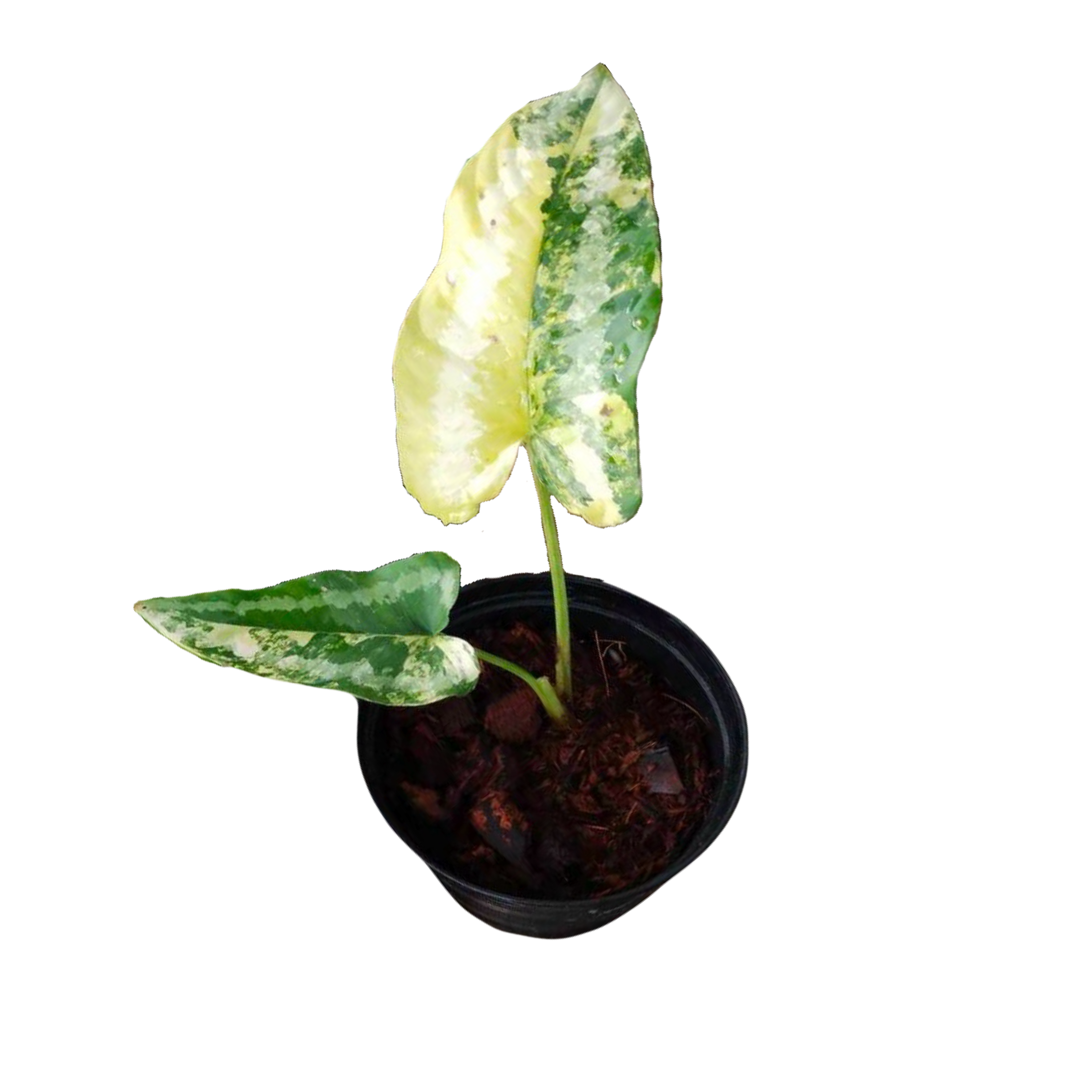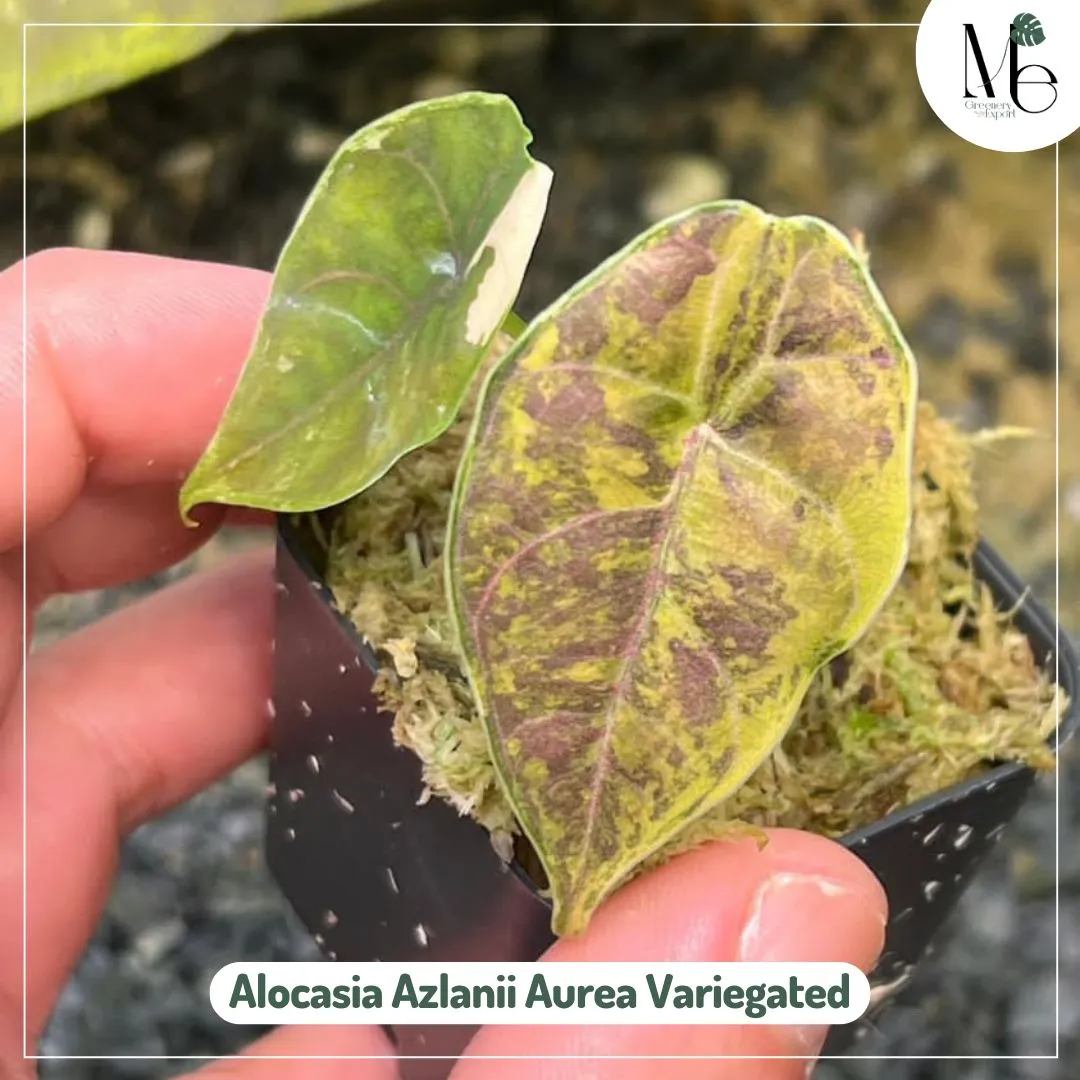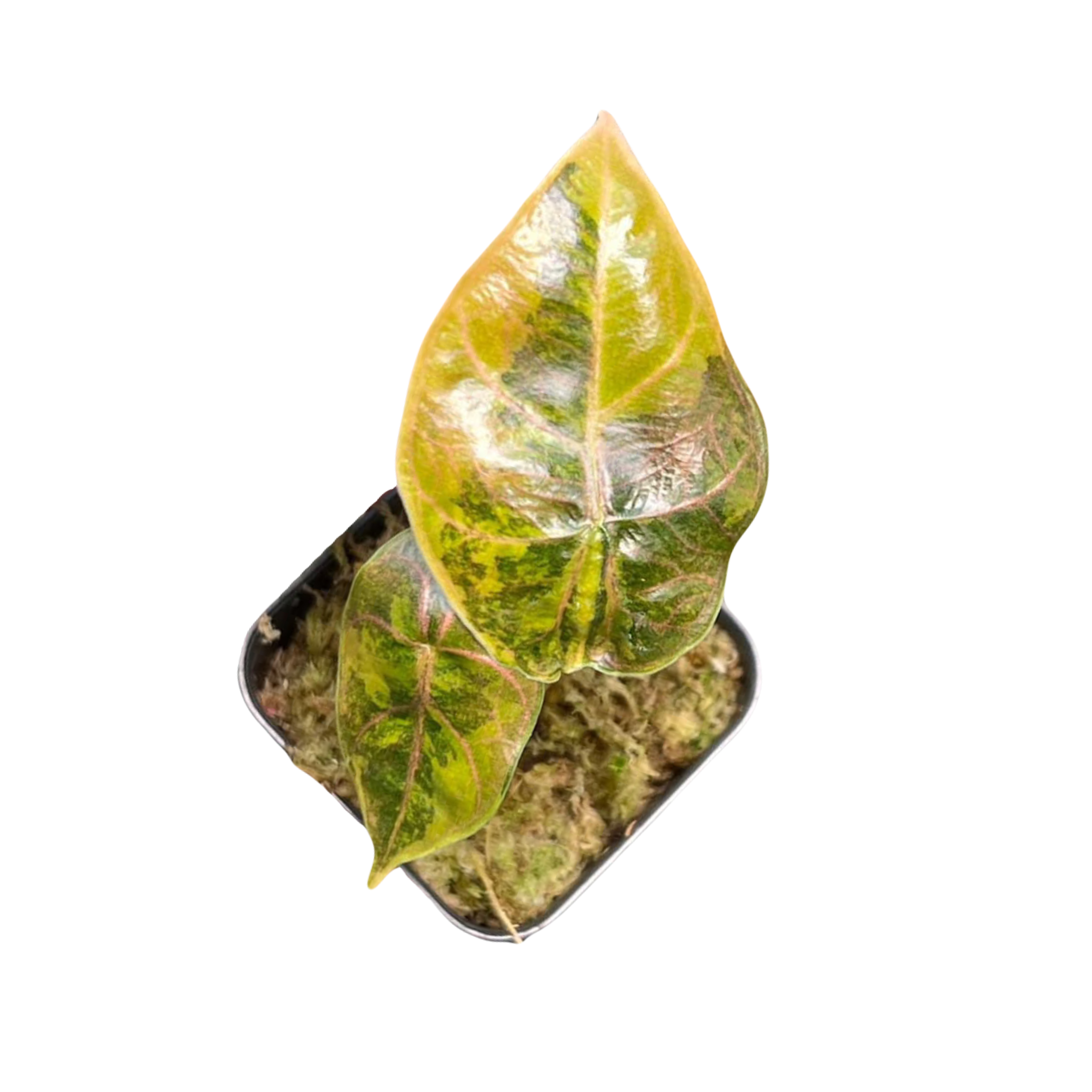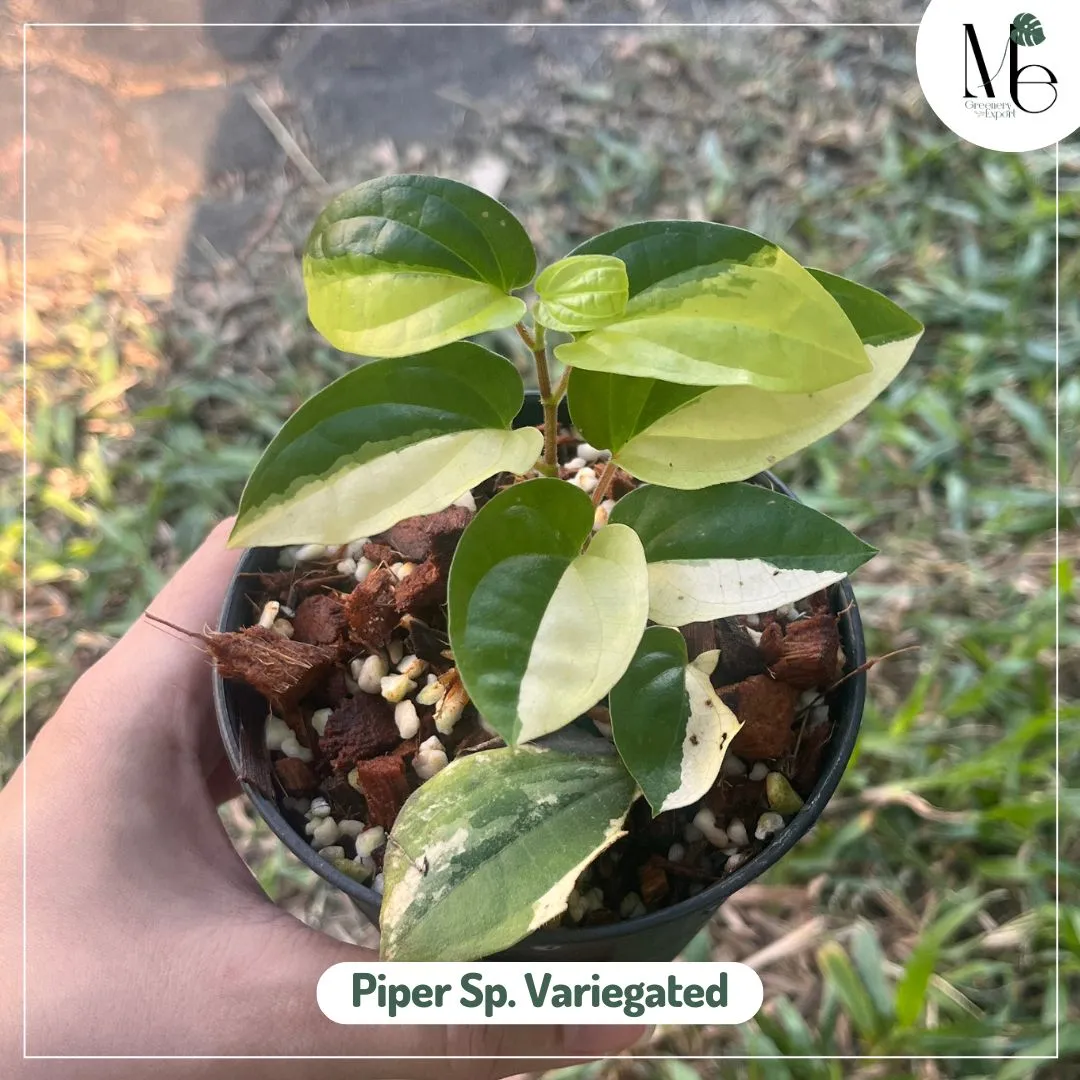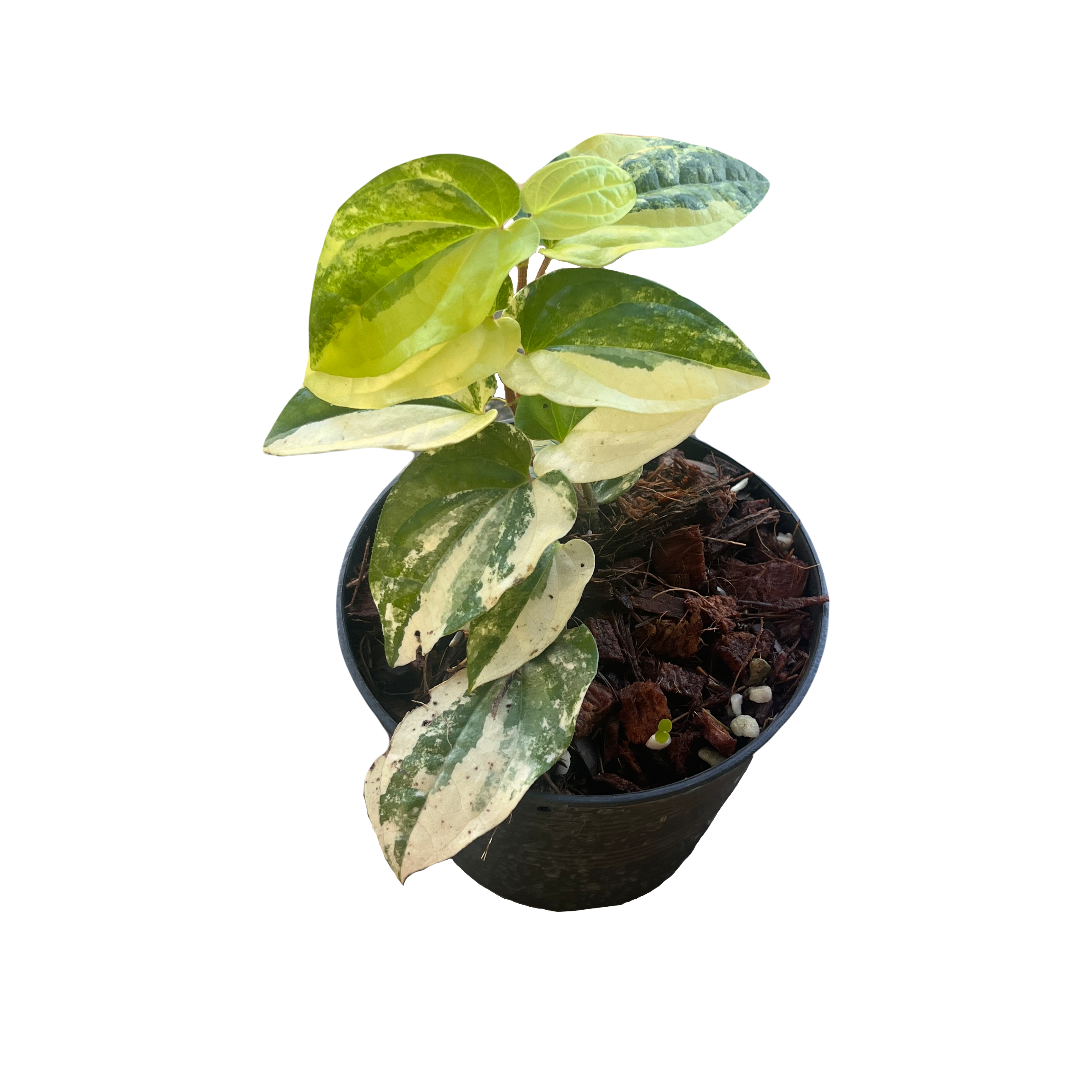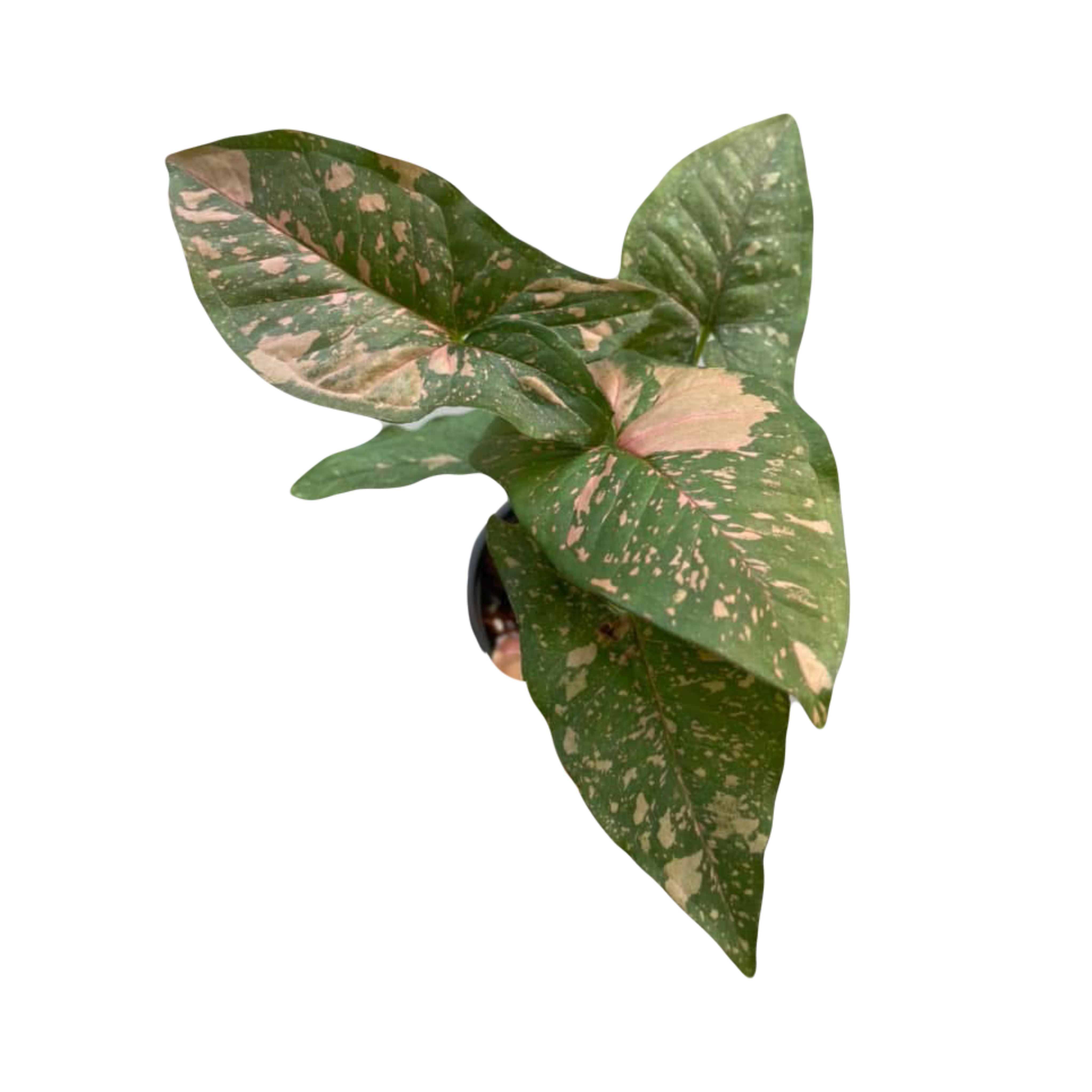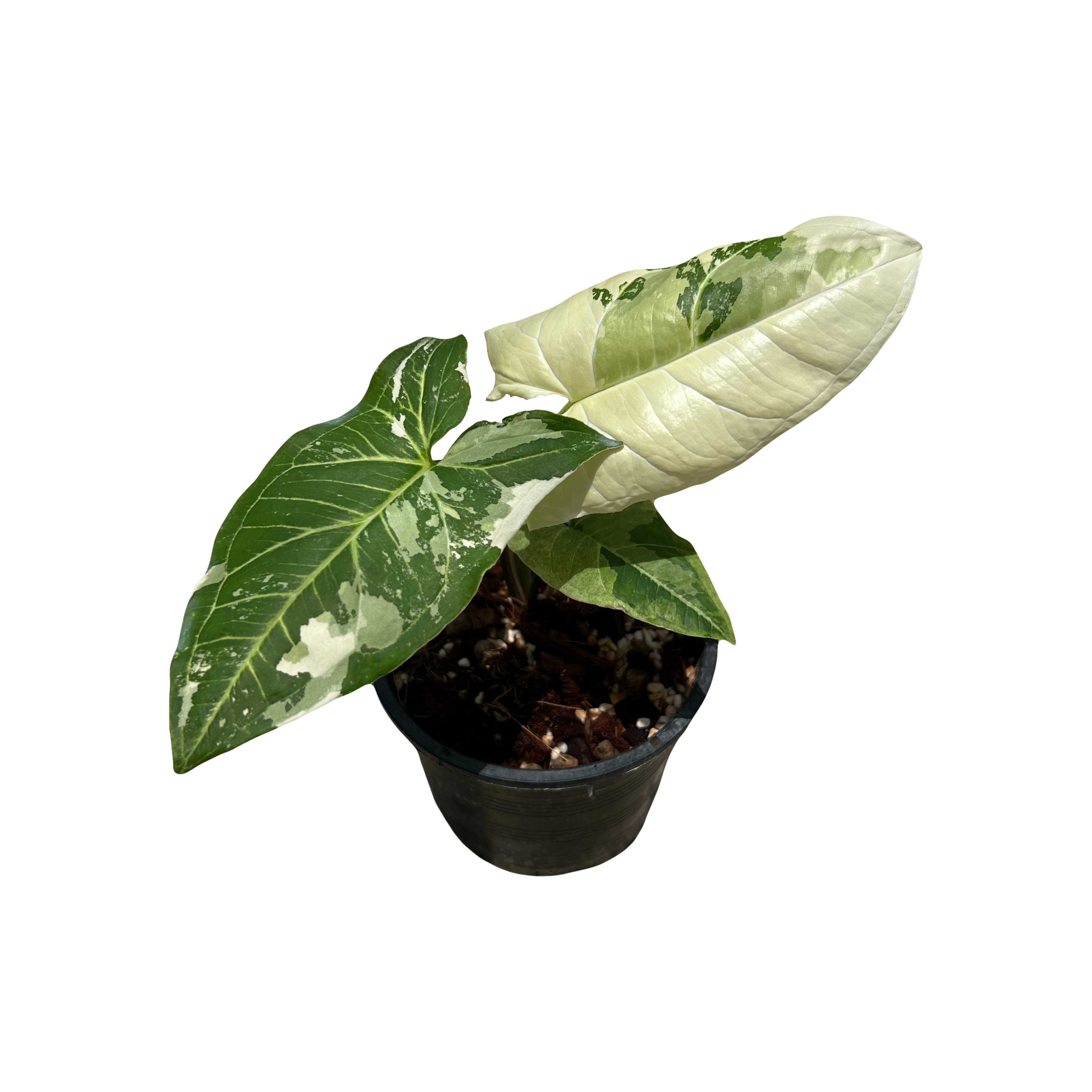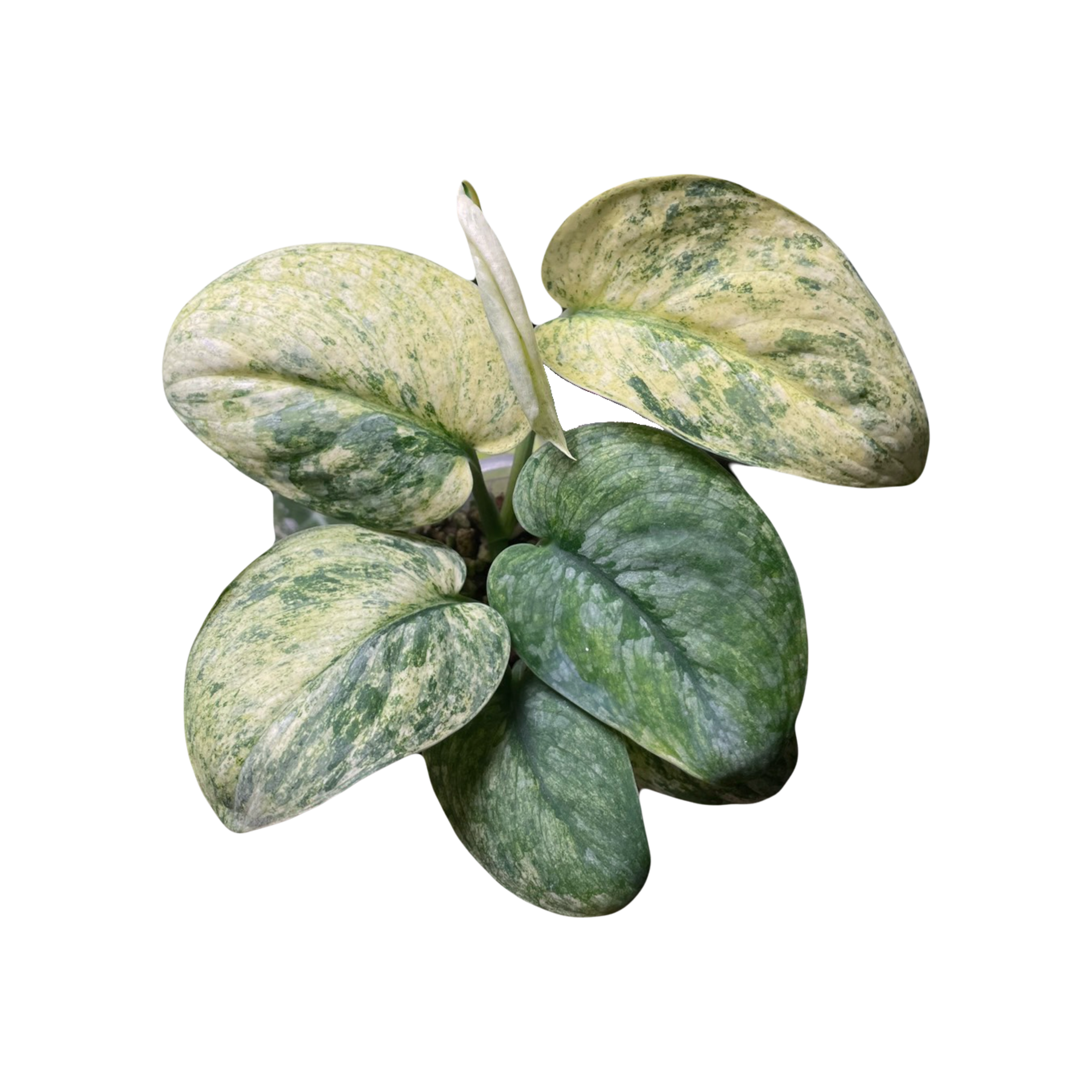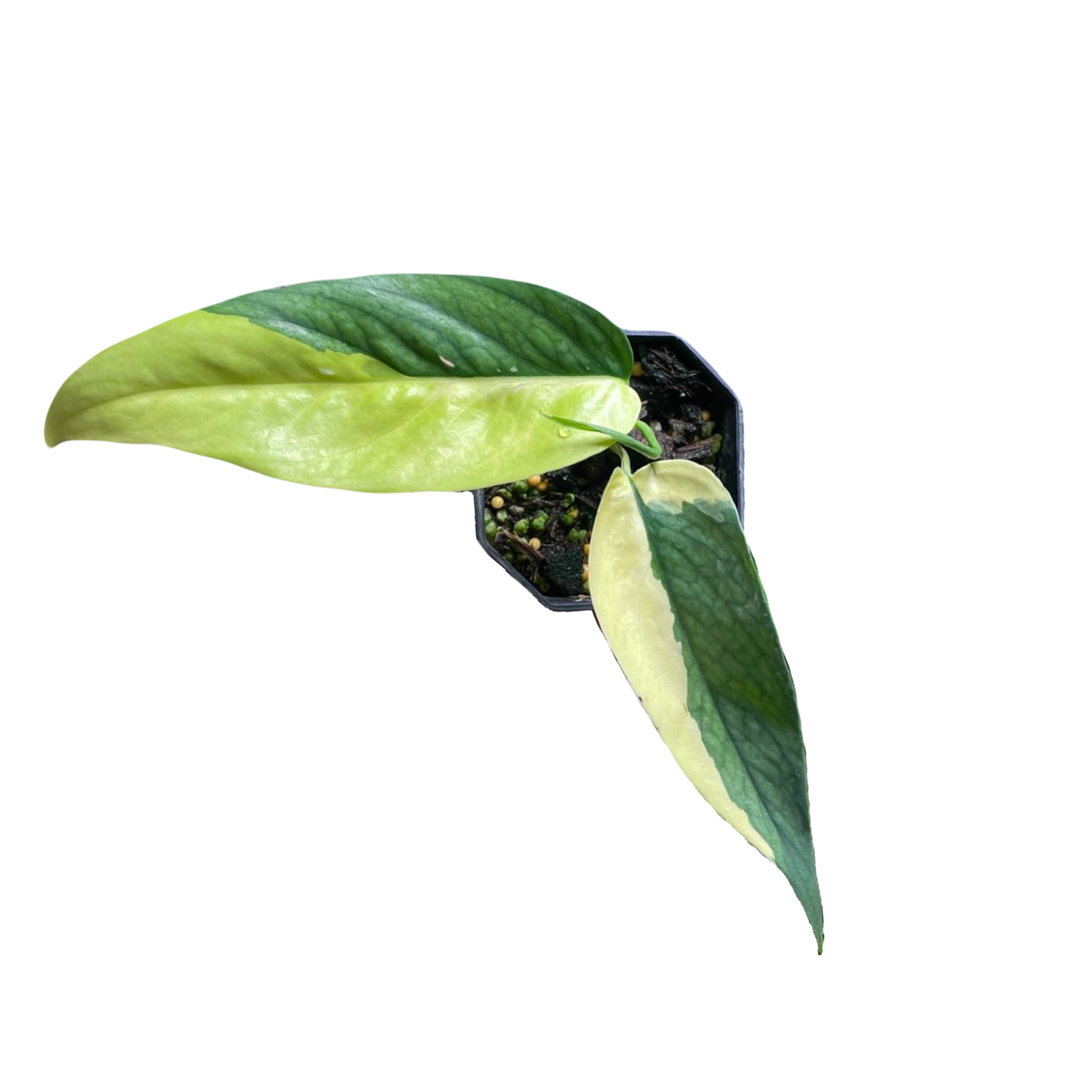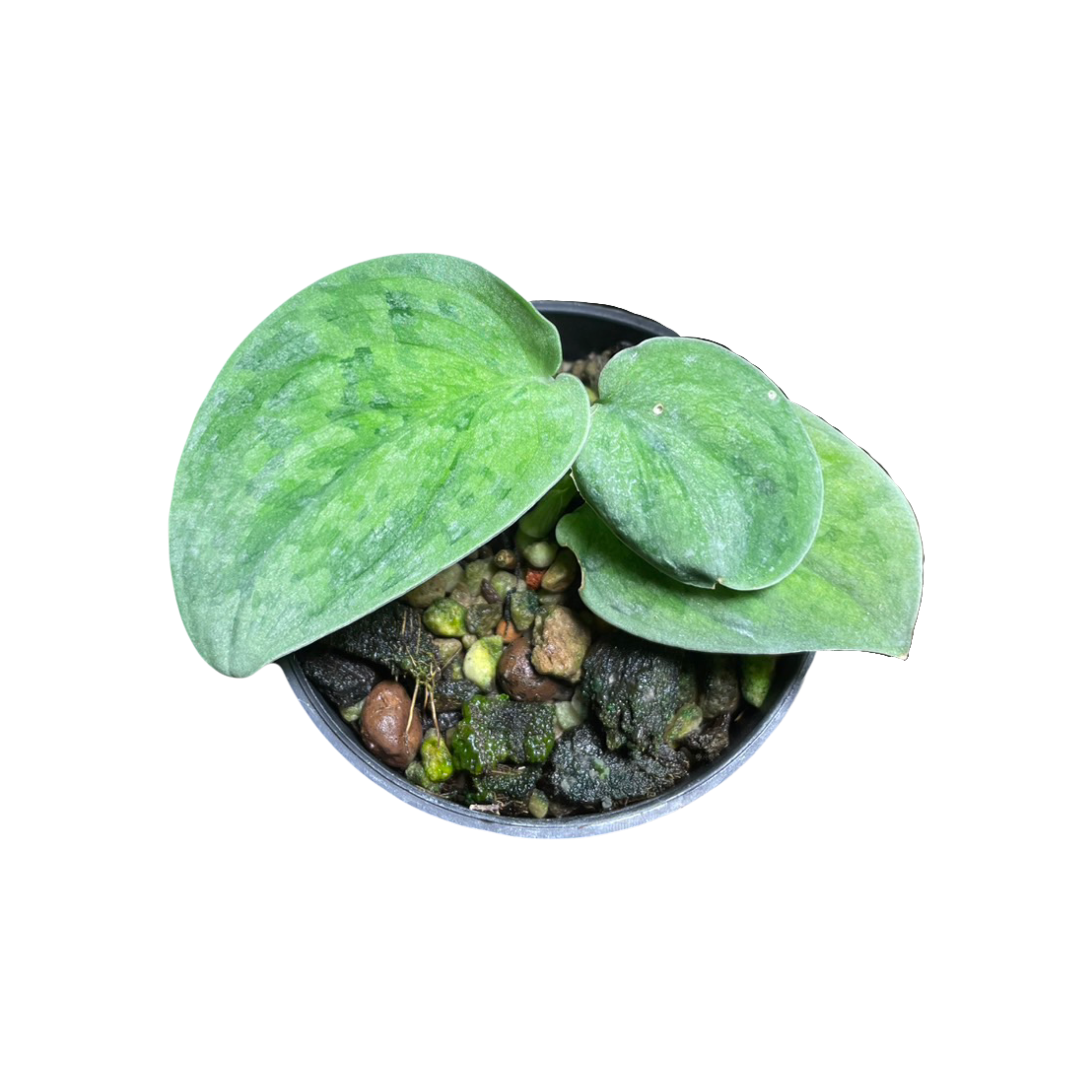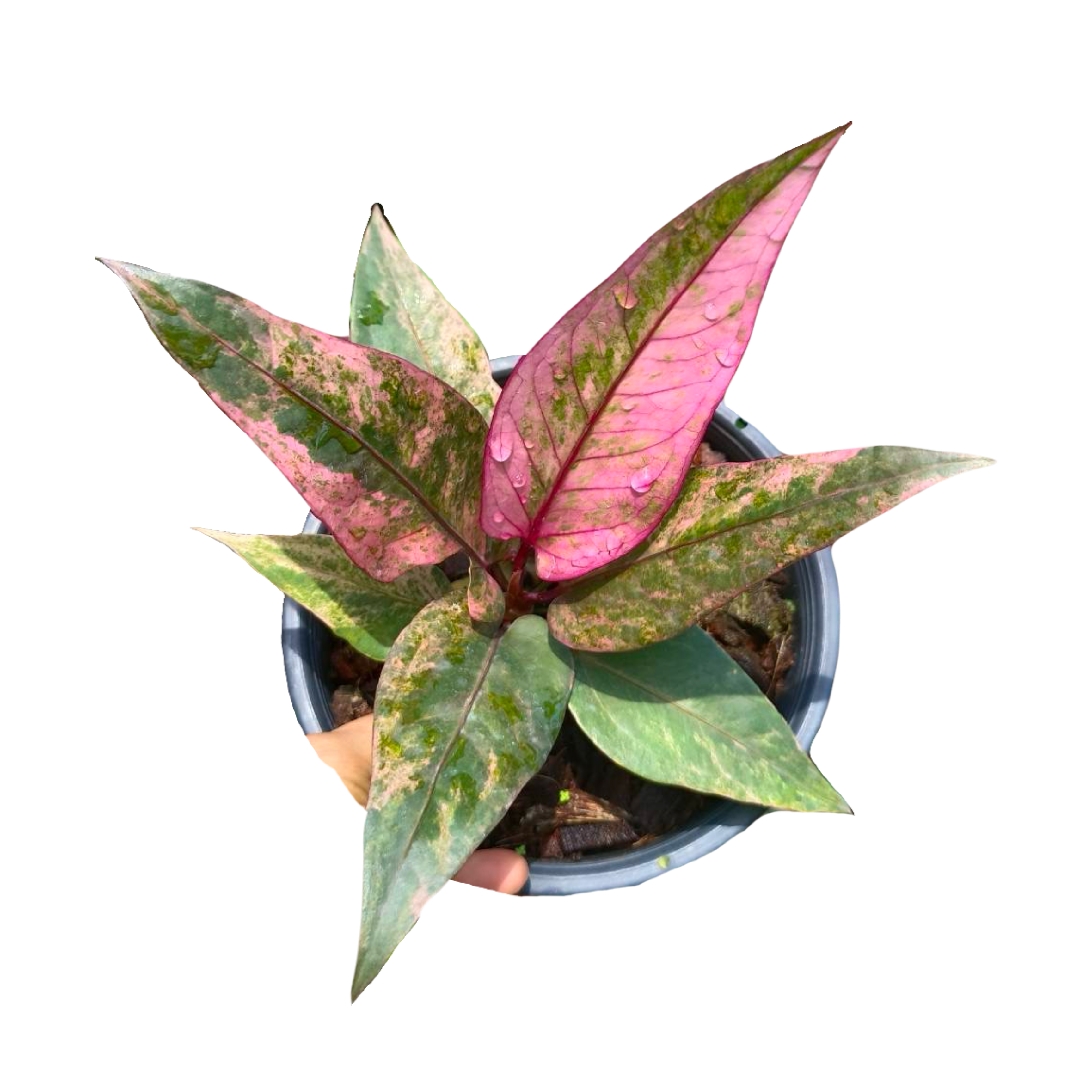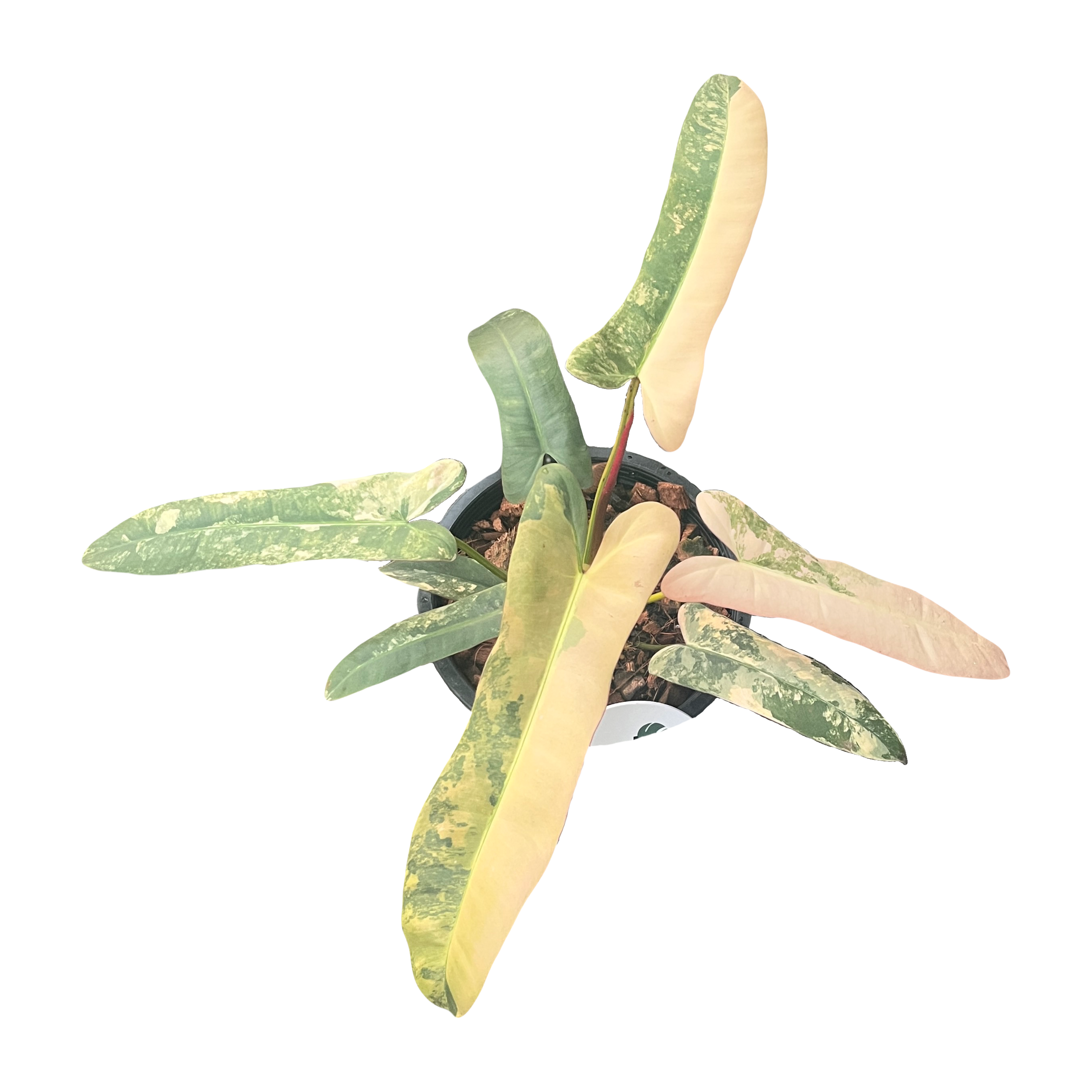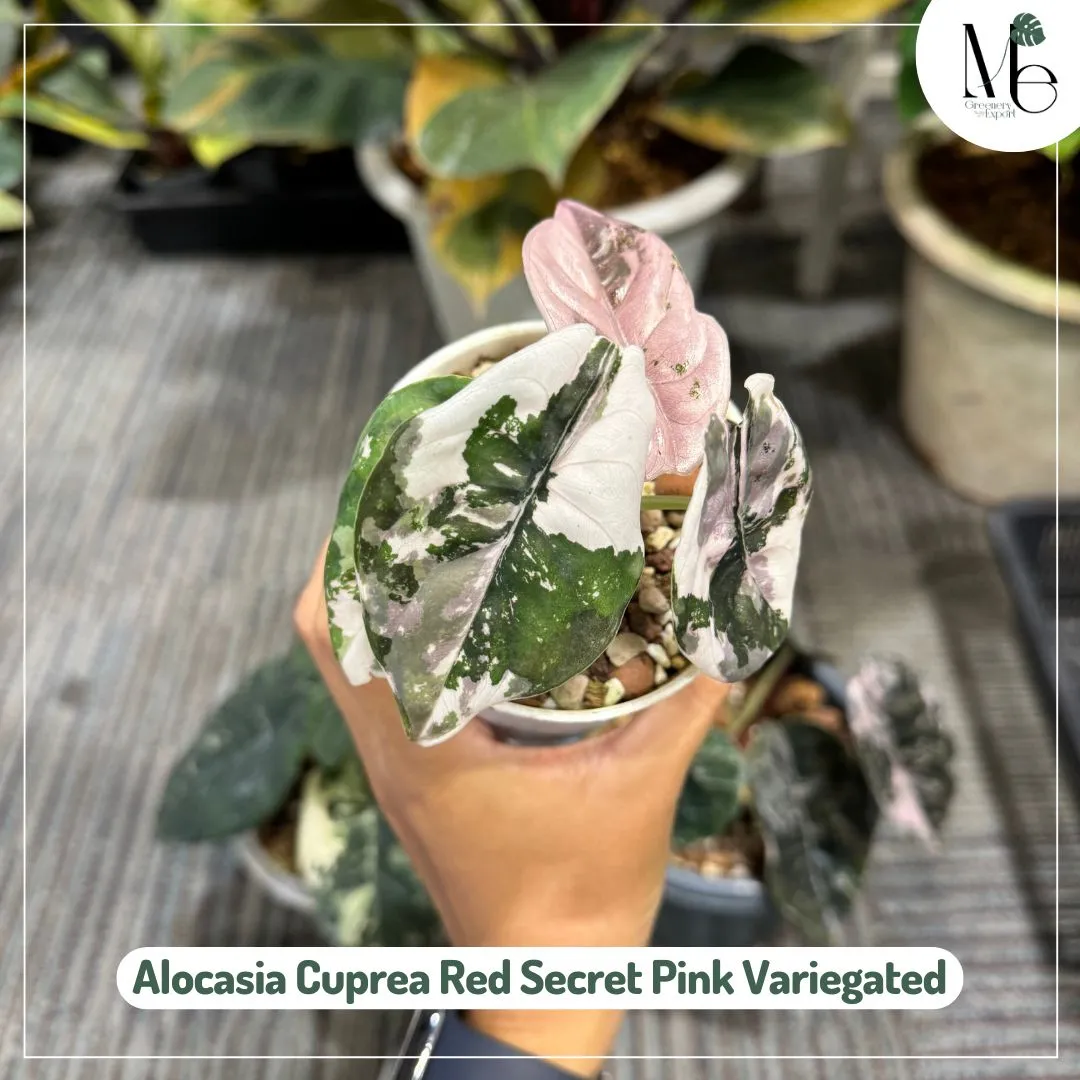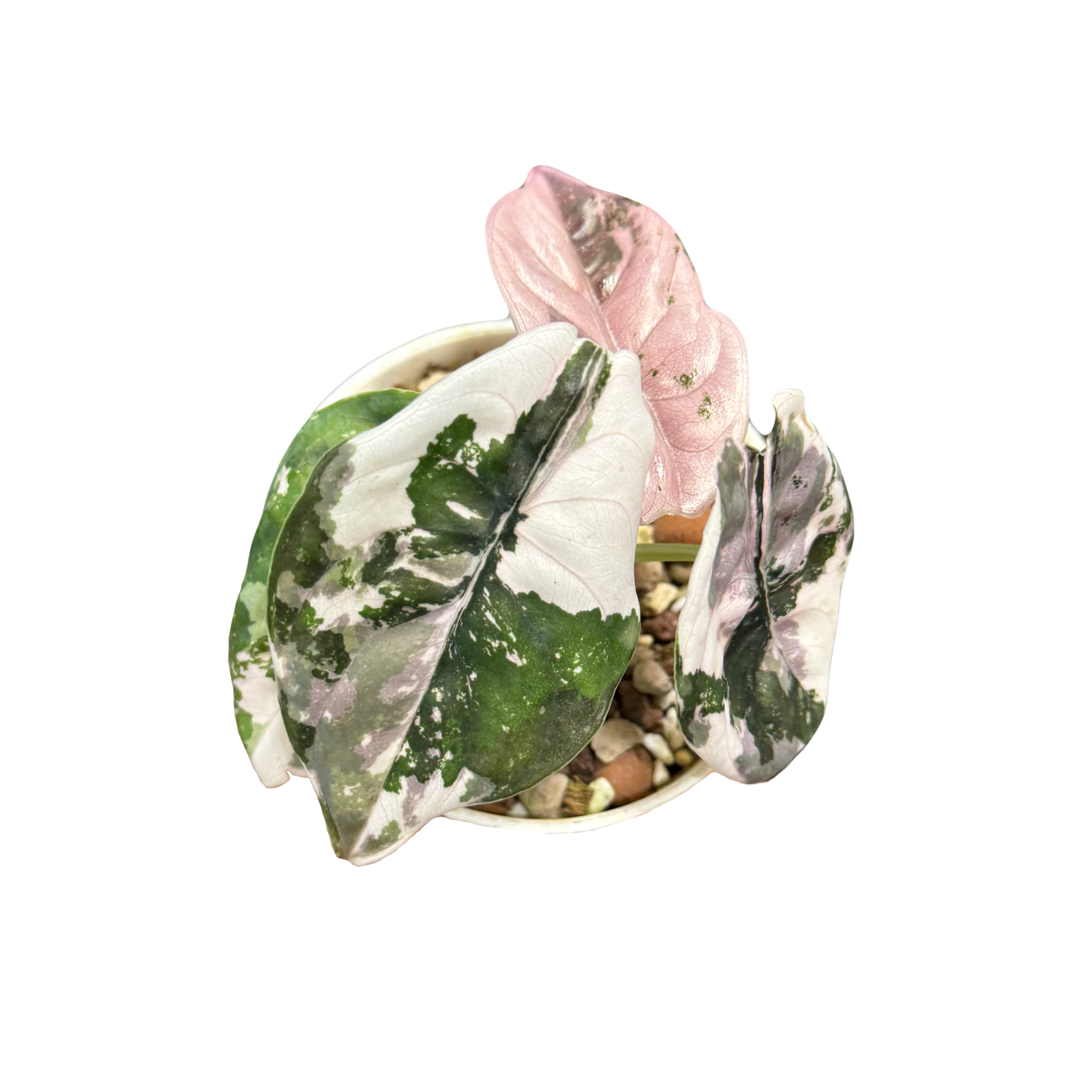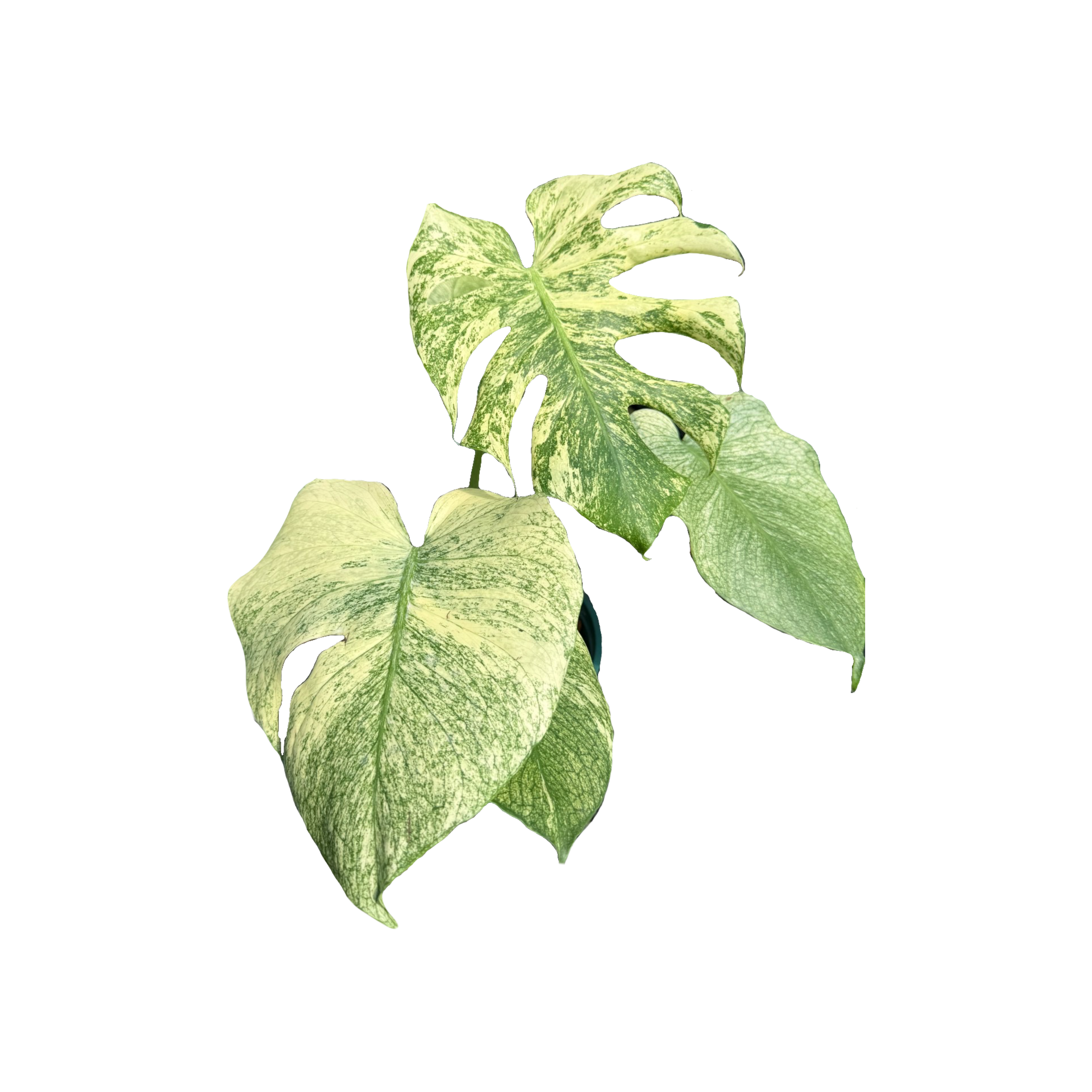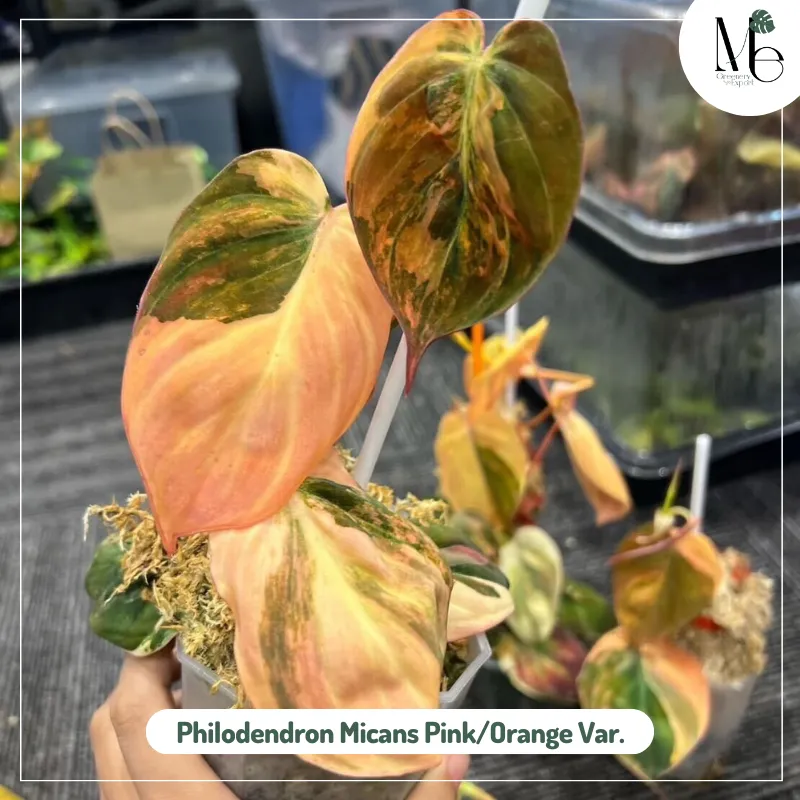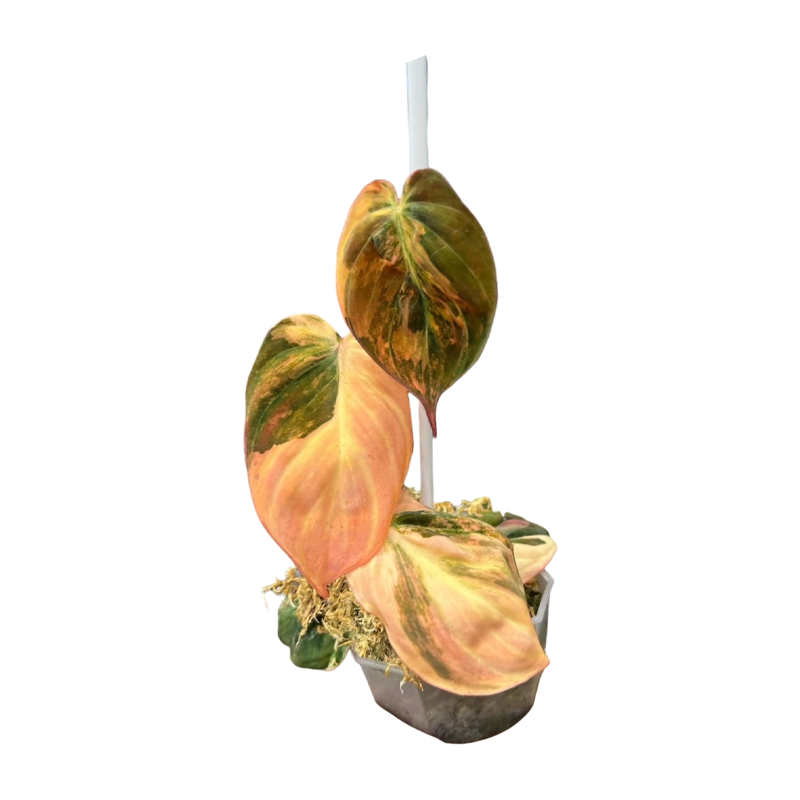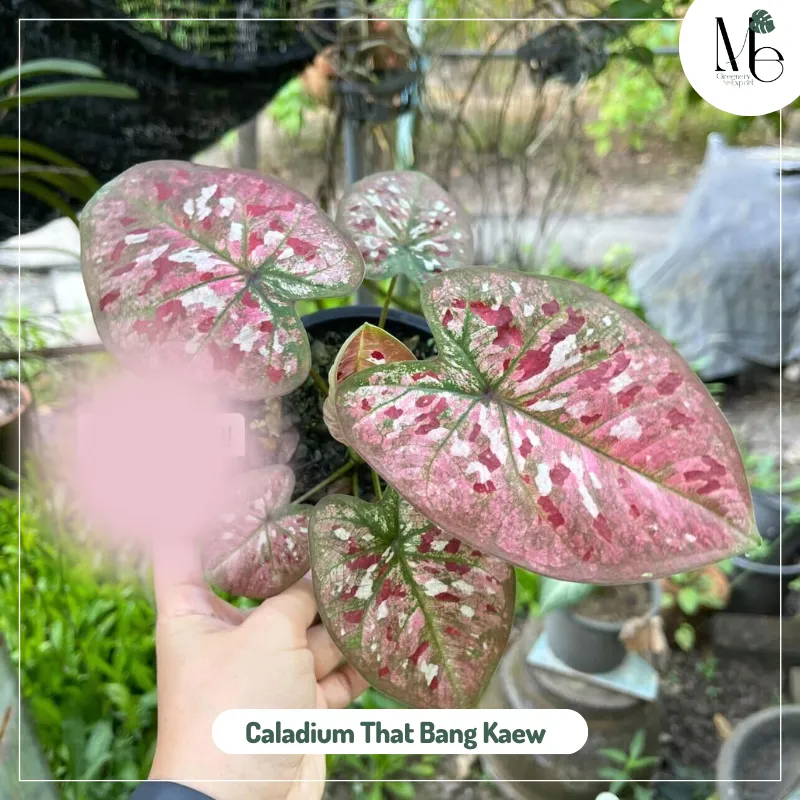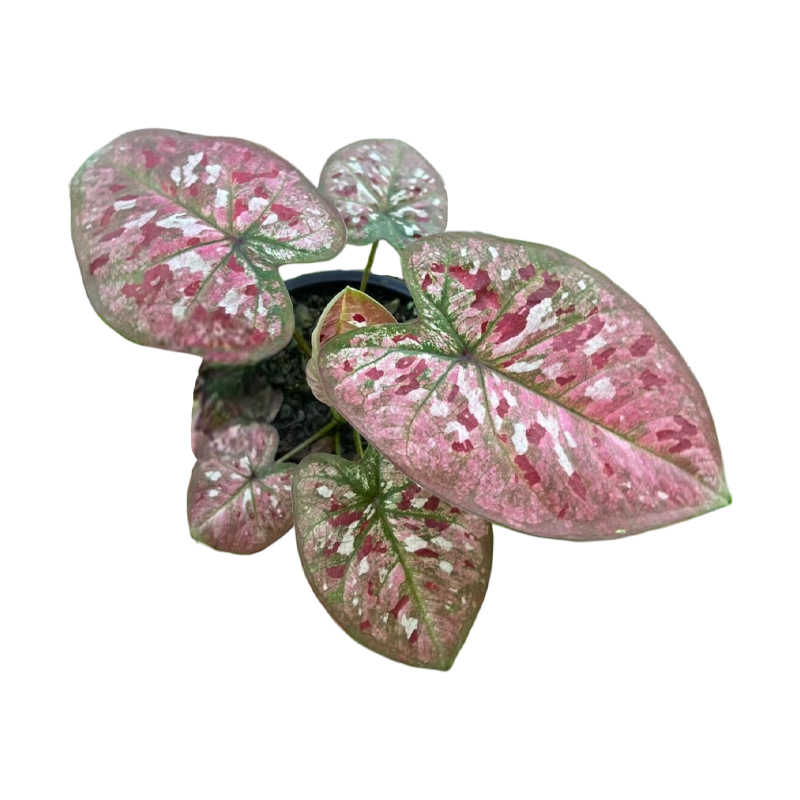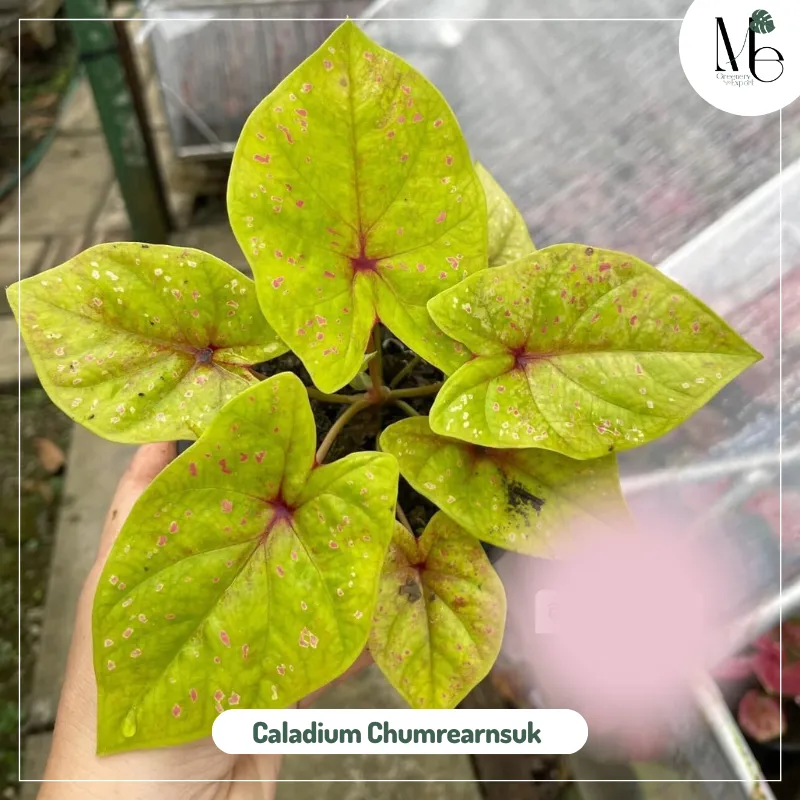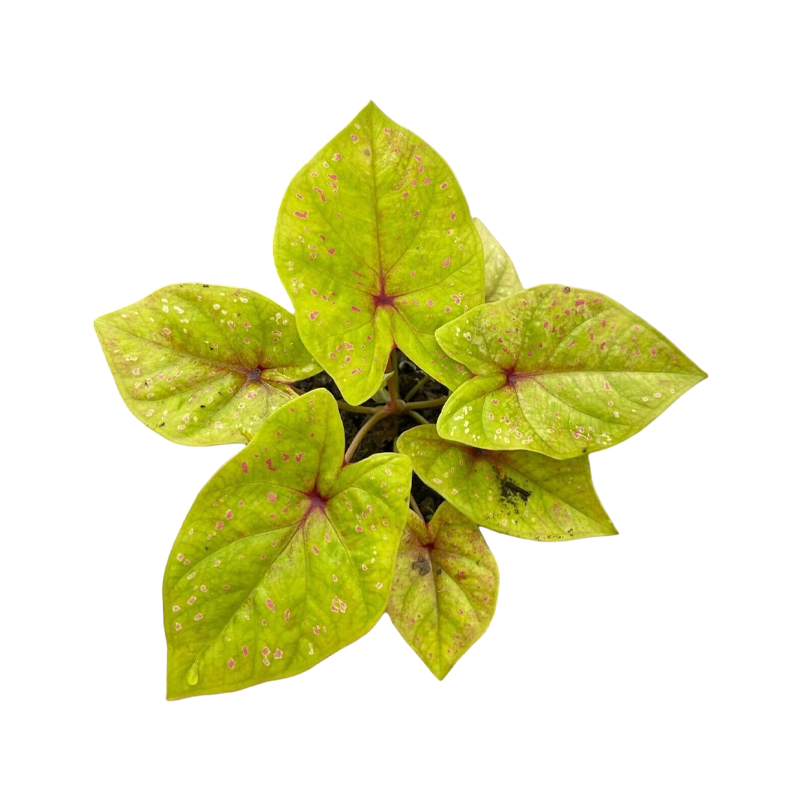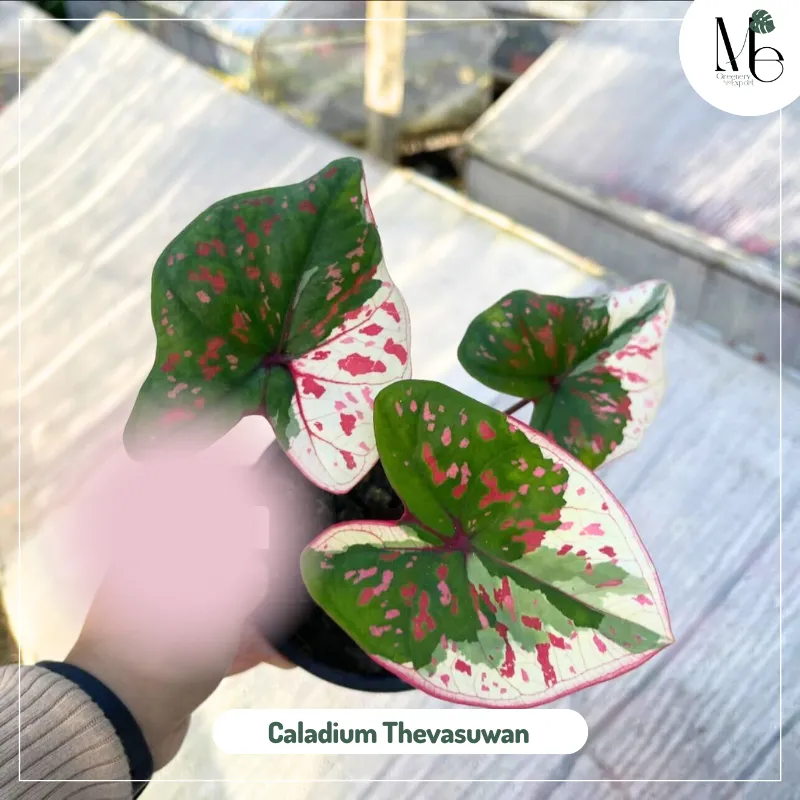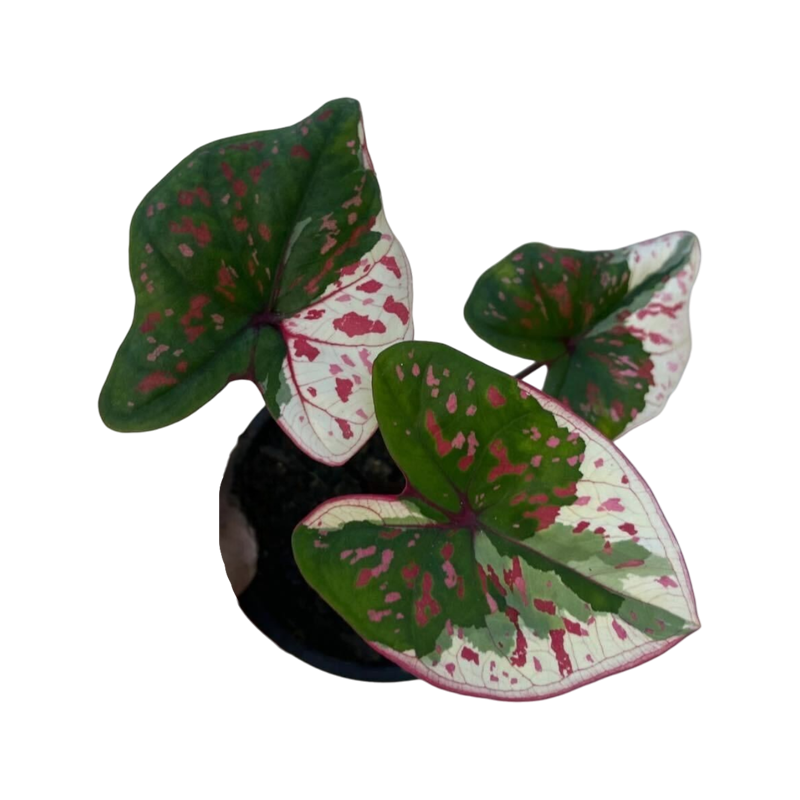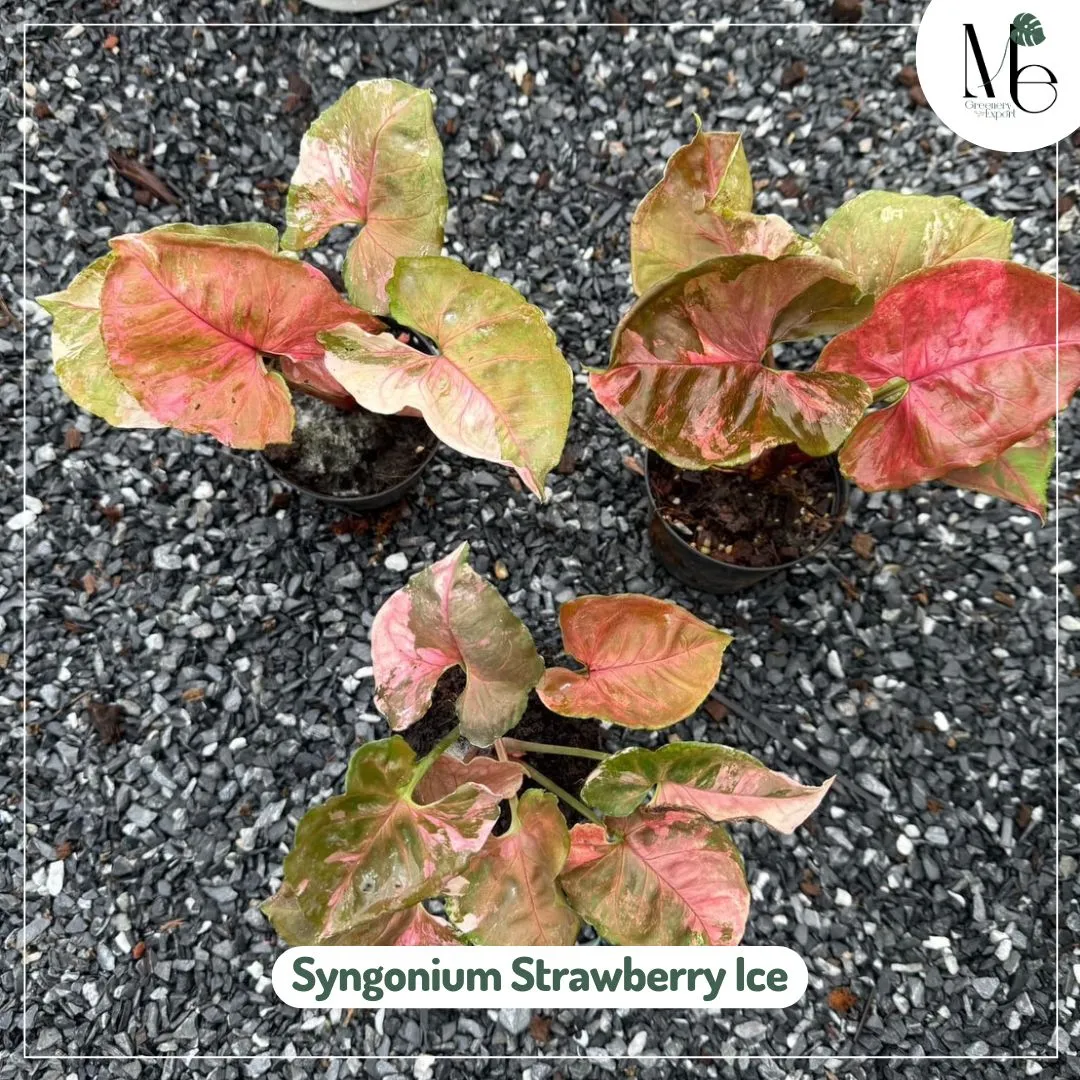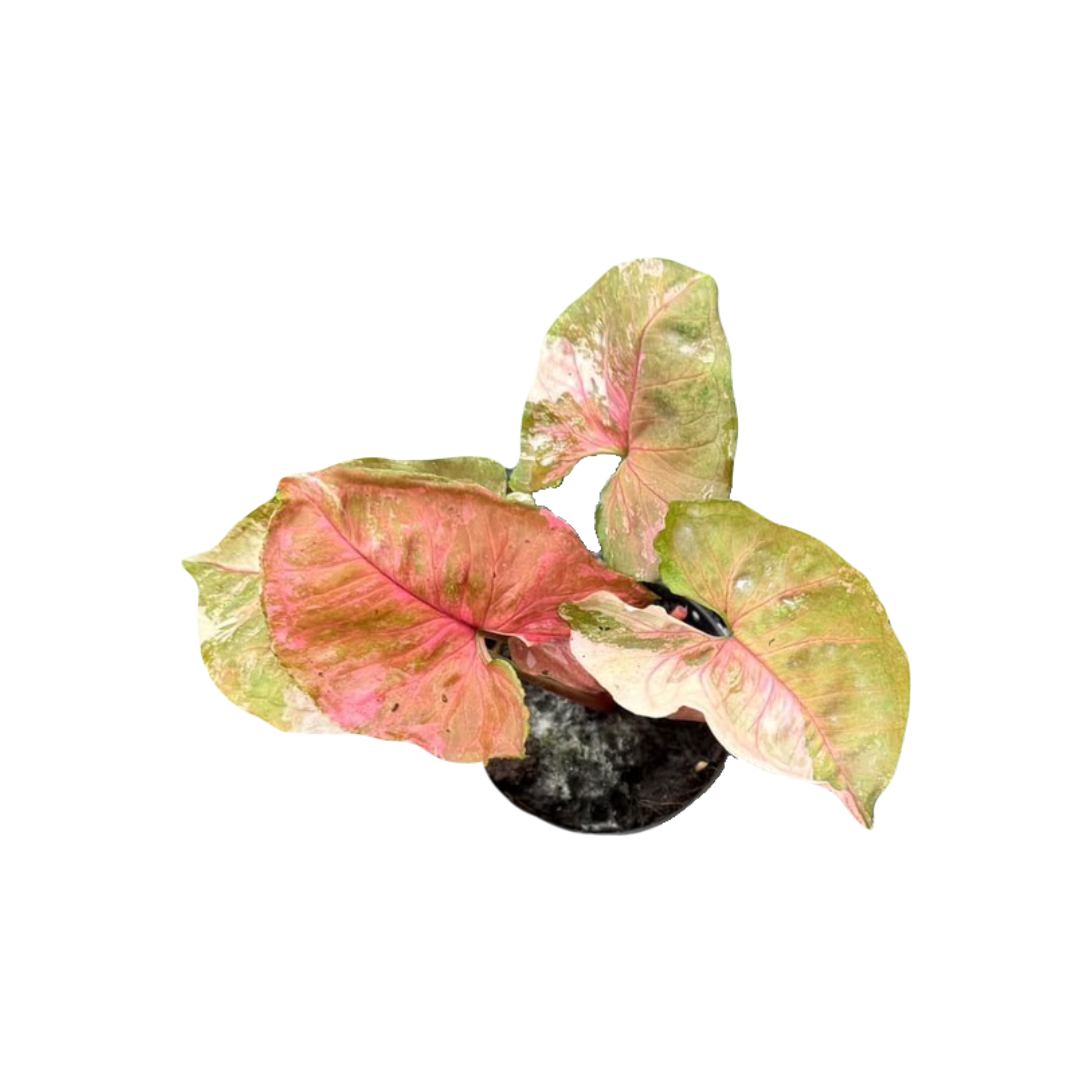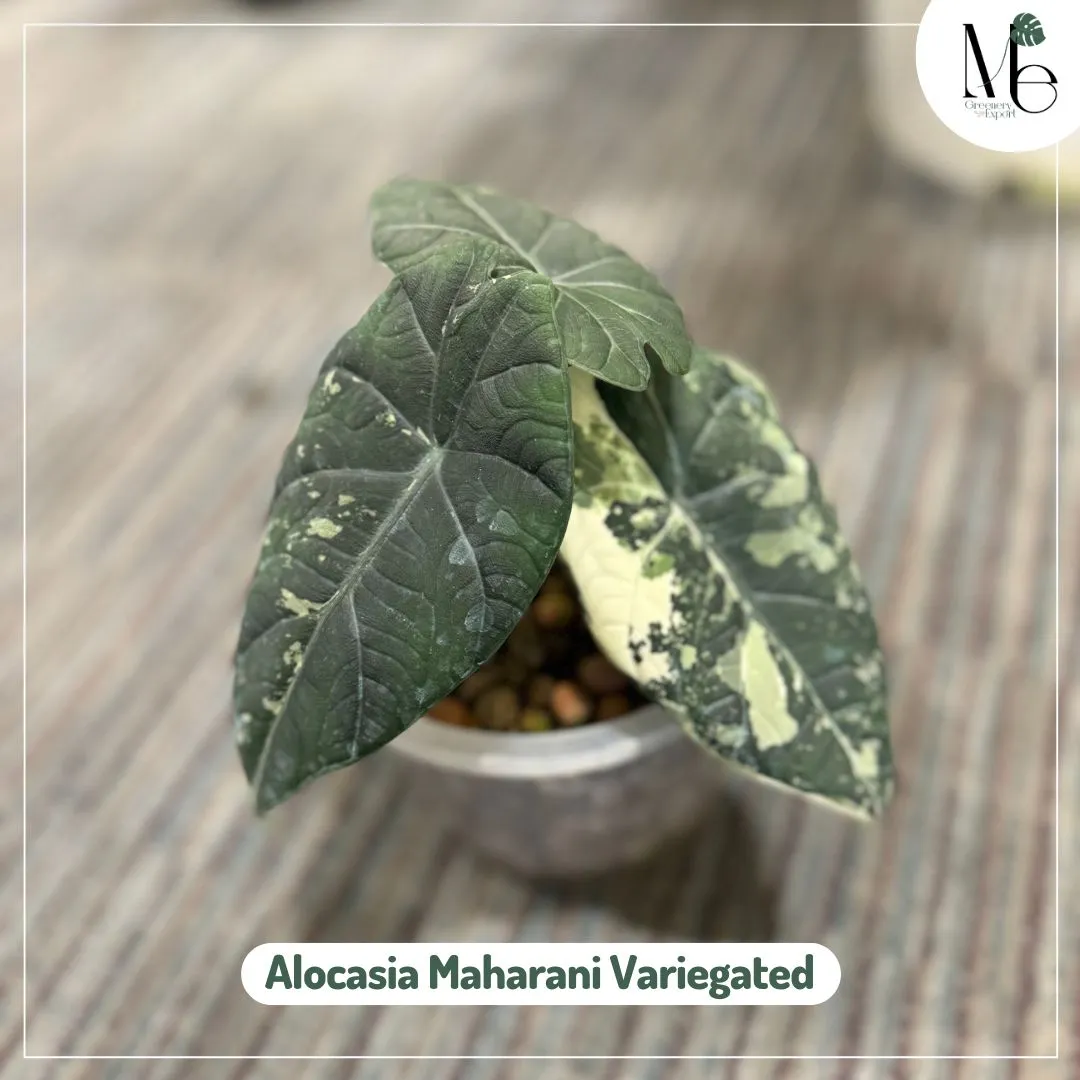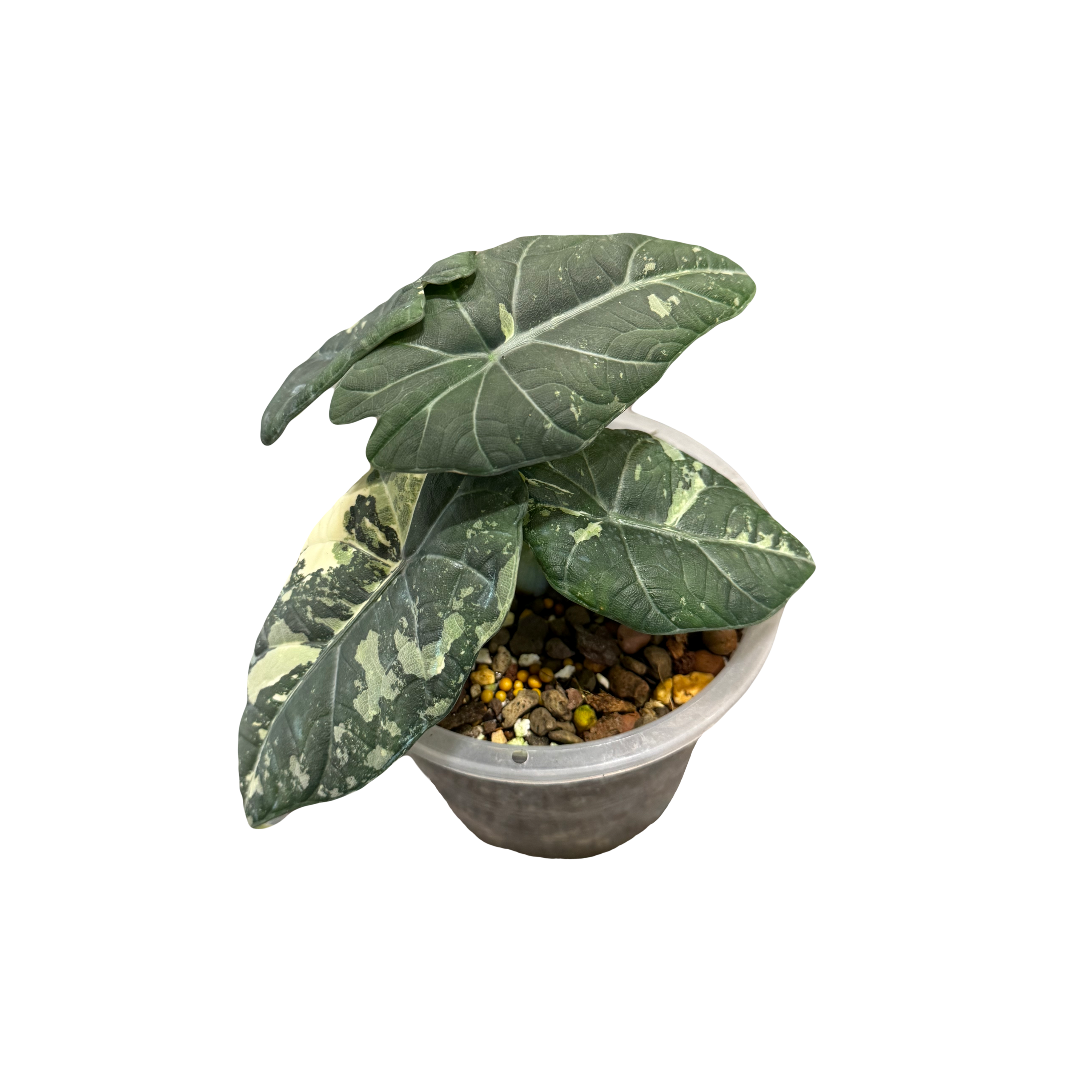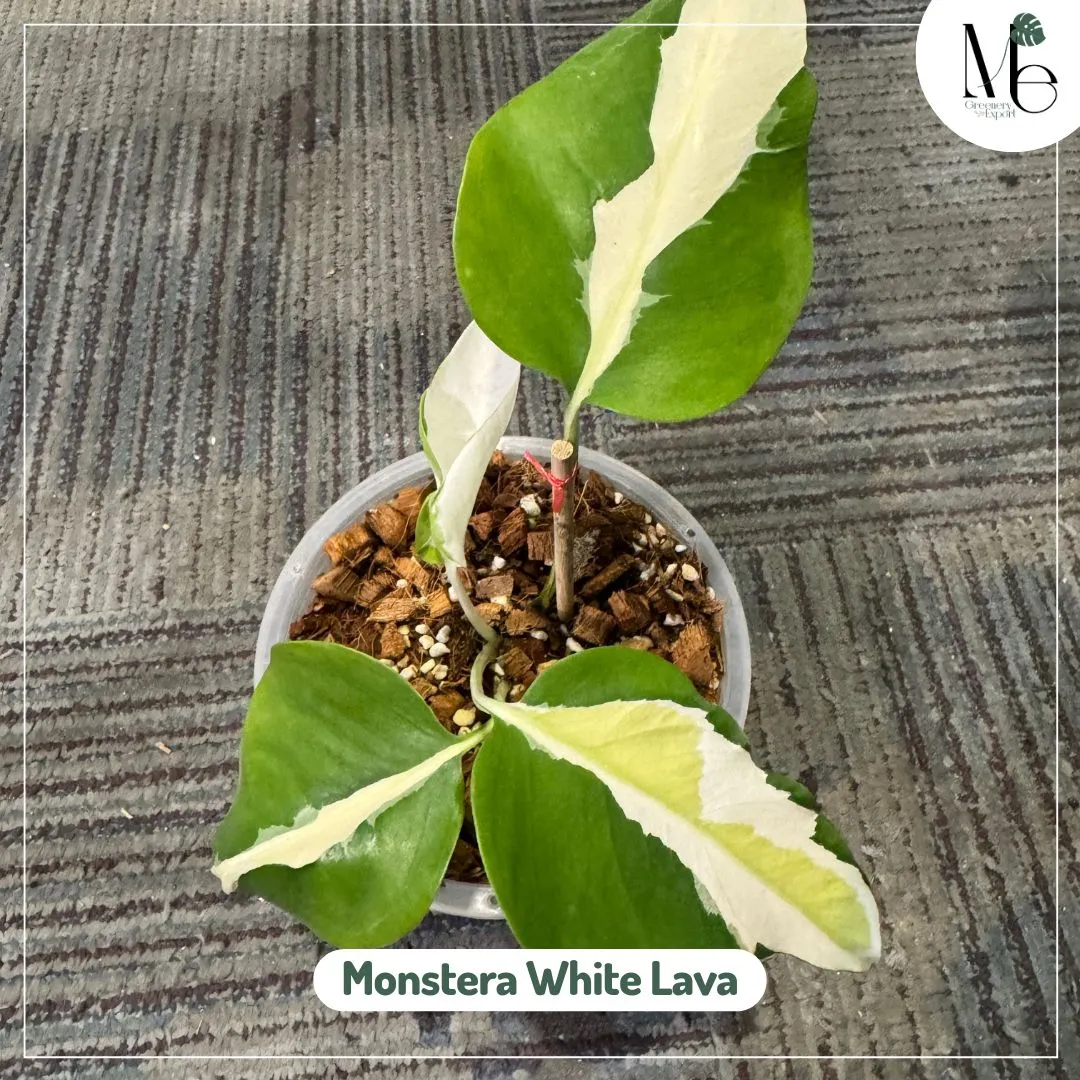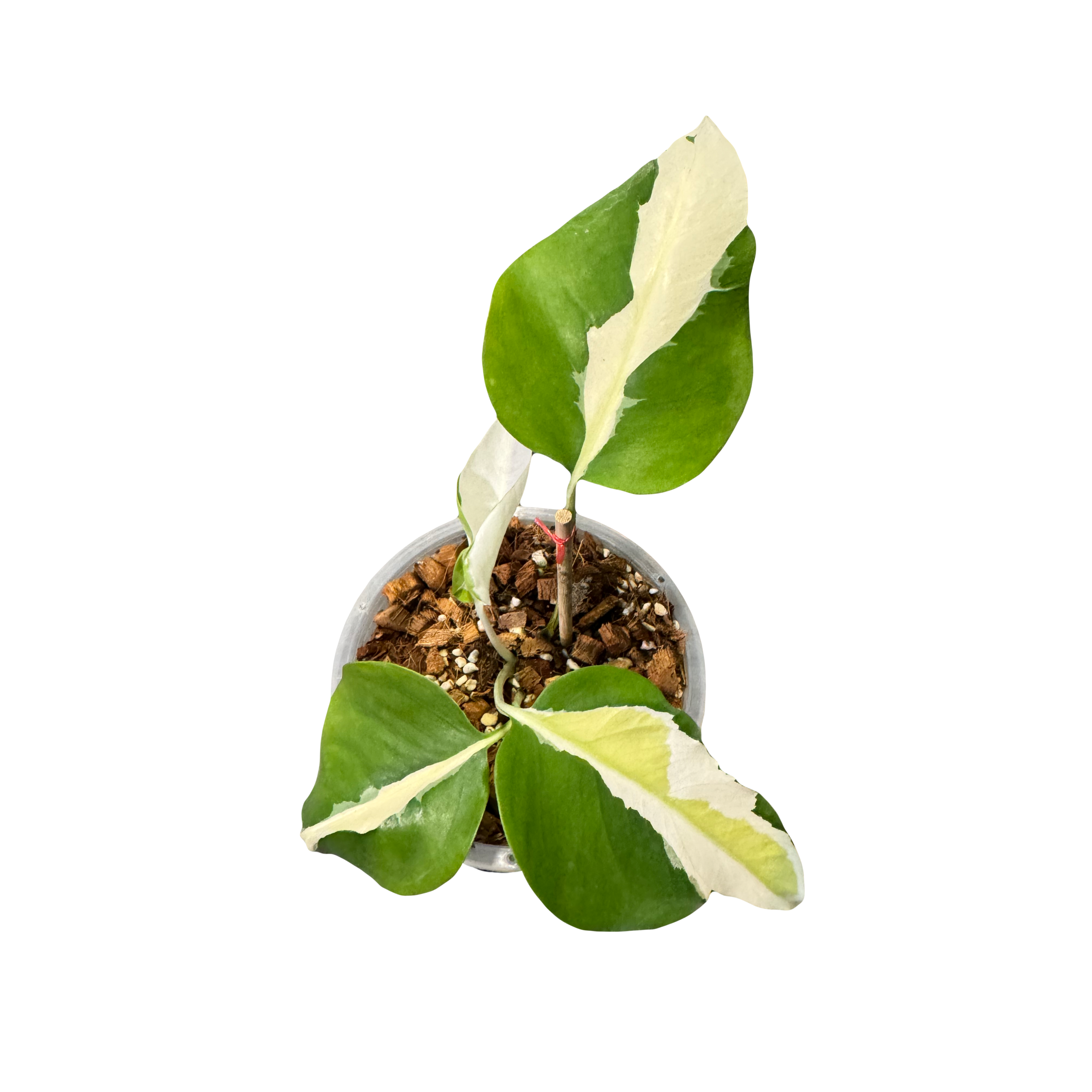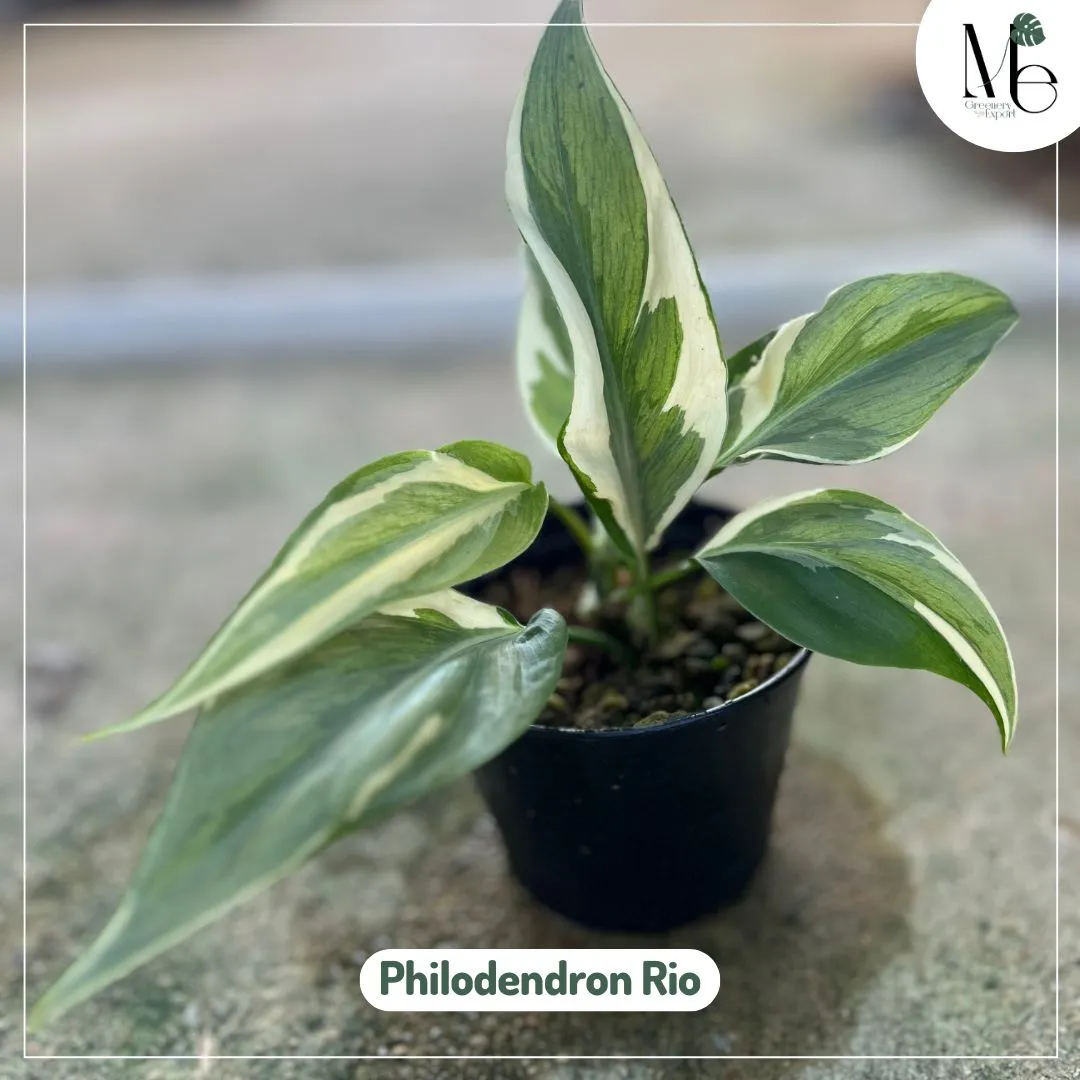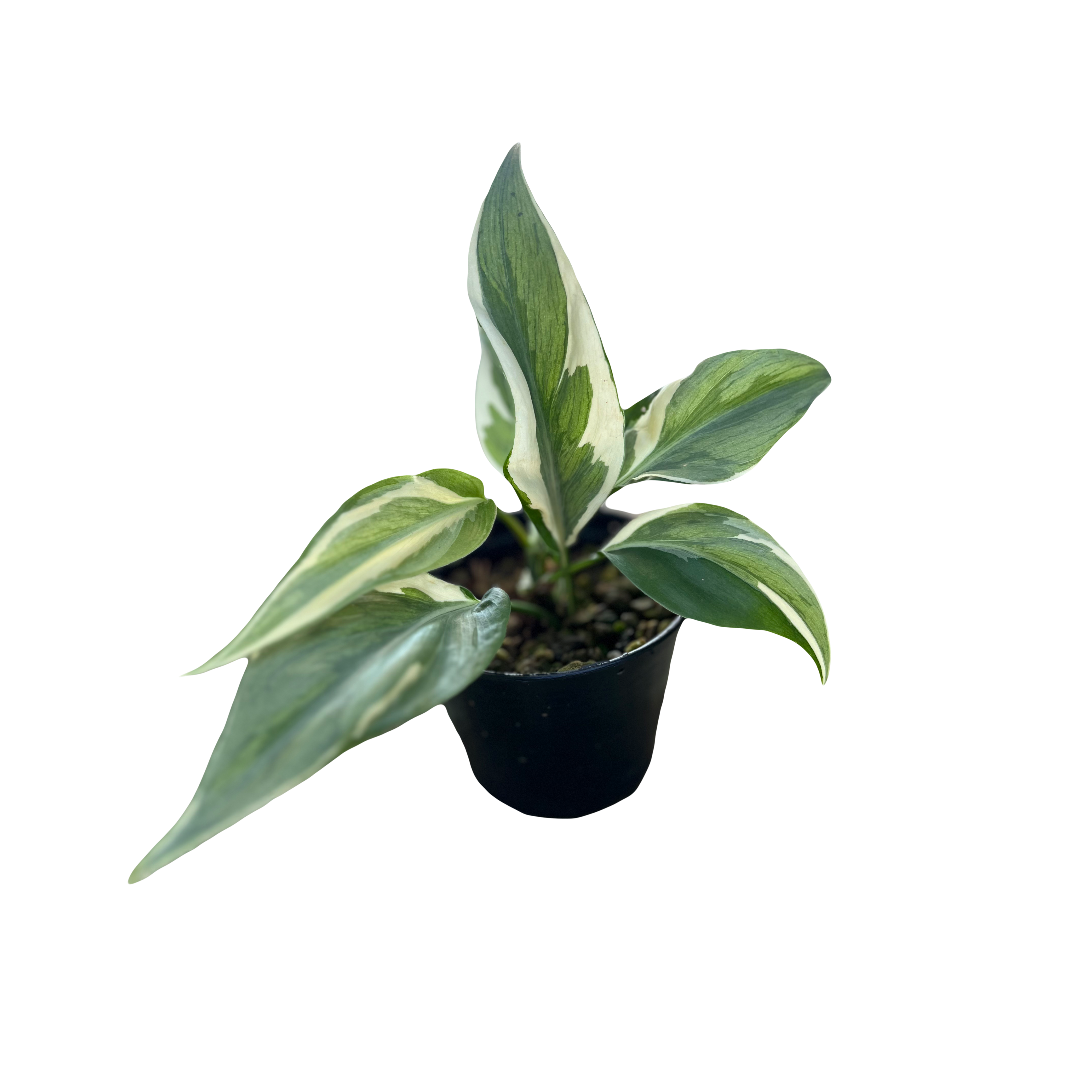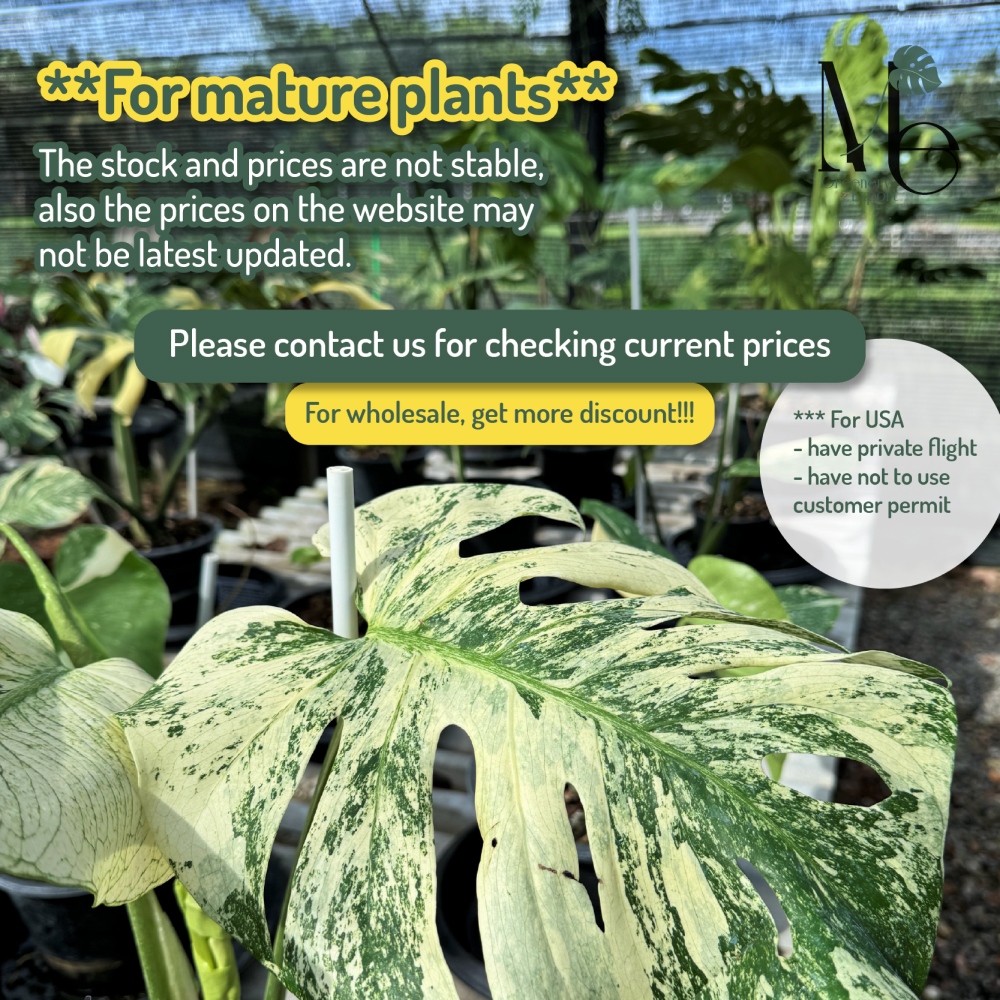Showing 61–80 of 281 resultsSorted by latest
Schismatoglottis Wallichii Variegated
Schismatoglottis Wallichii Variegated is an eye-catching, tropical perennial plant belonging to the Araceae family, often sought after by plant enthusiasts due to its beautiful, variegated foliage. This plant is native to Southeast Asia and is a part of the broader genus Schismatoglottis, which contains many species known for their ornamental value. How to care Light: Requires bright, indirect light to maintain its vibrant patterns. Soil: Thrives in soils that hold some moisture but do not become soggy. Watering: Avoid overwatering, which can cause root rot. Humidity: Thrives in humid conditions, with humidity levels ideally around 60% or higher. Temperature: Prefers temperatures between 65-80°F (18-27°C) and should be protected from drafts and cold temperatures, which can damage the leaves. How to order *The first image is just for advertising. [post-views]
Share this:
Alocasia Azlanii Aurea Variegated
Alocasia Azlanii Aurea Variegated is a rare and visually striking variety of the Alocasia plant, known for its unique combination of features. The leaves of this variety are glossy, arrow-shaped, and highly ornamental. They usually have bold, contrasting patterns of green and golden-yellow variegation, which makes them stand out. The variegation is often irregular, with some leaves displaying vibrant golden hues along the veins or edges. How to care Light: Thrives in bright, indirect light. Too much direct sunlight can scorch its delicate leaves Soil: Well-draining, aerated potting mix is essential for this plant. Watering: Prefers regular watering but dislikes soggy roots. Make sure the top few inches of soil dry out before watering again. Overwatering can lead to root rot. Humidity: Enjoys high humidity, so it’s ideal to keep it in a humid environment (around 60% or more). Temperature: Thrives in temperatures between 65°F to 80°F (18°C to 27°C) and should not be exposed to temperatures below 50°F (10°C). How to order *The first image is just for advertising. [post-views]
Share this:
Piper Sp. Variegated
Piper sp. Variegated is a rare and stunning variety of the Piper genus, renowned for its beautiful variegated foliage. This plant is simply too gorgeous to ignore, with its striking combination of green, white, and cream or yellow hues that create a marbled, eye-catching effect on its glossy, heart-shaped leaves. It’s a perfect choice for those looking to add a unique and colorful touch to their indoor space. How to care Light: Thrives in bright, indirect light. The variegation will stay vibrant in adequate light, while low light can cause the colors to fade. Soil: Use a well-draining potting mix. A standard indoor potting mix with added perlite or coconut coir works well to keep the soil aerated and prevent waterlogging. Watering: Water the plant when the top 1-2 inches of soil feel dry to the touch. Be careful not to overwater, as it can lead to root rot. Humidity: Enjoys higher humidity levels (60% or more). Temperature: Prefers temperatures between 60°F and 85°F (15°C to 29°C) and should be kept away from cold drafts or sudden temperature changes. How to order *The first image is just for advertising. [post-views]
Share this:
Syngonium Pink Allusion
Syngonium Pink Allusion is a stunning and unique cultivar of the Syngonium genus, a popular group of houseplants known for their attractive, arrow-shaped leaves. The Syngonium Pink Allusion stands out due to its beautiful pink-hued variegation that adds a vibrant and colorful element to any indoor space. How to care Light: Thrives in bright, indirect light but can also tolerate lower light conditions. Soil: Use a well-draining potting mix that retains moisture but does not stay soggy. A general indoor potting mix with added perlite or orchid bark for extra drainage works well. Watering: Prefers to be kept relatively moist but not waterlogged. Water it when the top 1-2 inches of soil feel dry to the touch. Humidity: Appreciates higher humidity levels (around 60% or more). Temperature: Does best in temperatures ranging from 60°F to 80°F (15°C to 27°C). Avoid placing it in areas where the temperature fluctuates dramatically.
Start from $ USD
How to order *The first image is just for advertising. [post-views]Share this:
Syngonium Batik Variegated
Syngonium Batik Variegated is a beautiful and unique cultivar of the Syngonium genus which is less commonly found. The Batik variety stands out due to its leaf patterns. The leaves are arrow-shaped leaves that display a mix of green and creamy white or light yellow hues variegation on a green "batik" pattern. How to care Light: Prefers bright, indirect light. The more light it receives, the more vibrant the variegation tends to be. But direct sunlight can scorch the leaves. Soil: Well-draining, airy potting mix is essential to prevent root rot. A mix with peat, perlite, and orchid bark will work well. Watering: Keep the soil evenly moist but well-draining. Humidity: Thrives in moderate to high humidity, though it can tolerate average household humidity. Temperature: Average household temperatures are fine, but avoid drafts or sudden temperature changes.
Start from $ USD
How to order *The first image is just for advertising. [post-views]Share this:
Scindapsus Silver Dark Cloud Variegated
Scindapsus Silver Dark Cloud Variegated is a relatively rare and highly prized variety of Scindapsus, a genus known for its stunning foliage and easy-care nature. This particular cultivar stands out due to its unique dark, silvery-gray leaves with striking variegation, which creates a dramatic contrast. This plant is a vigorous grower, especially when provided with the right conditions. How to care Light: Bright, indirect light is best. But too little light can bring down the colors. Soil: A soil mix that doesn't retain too much water but allows for adequate moisture retention is the right choice. Watering: Keep the soil consistently moist but not soggy. Humidity: High humidity (60% or more) is ideal. Temperature: Keep the plant away from cold drafts and sudden temperature changes. It thrives in warm temperatures between 65°F and 85°F (18°C to 29°C).
Start from / plant
How to order *The first image is just for advertising. [post-views]Share this:
Epipremnum Pinnatum Cebu Blue Aurea Variegated
Epipremnum pinnatum Cebu Blue Aurea Variegated is a stunning and rare cultivar of the Epipremnum pinnatum species. The leaves are large, arrowhead-shaped leaves that are a silvery-blue with golden, creamy, or yellow variegation. This variegation can vary, with some leaves having just a hint of golden streaks, while others may have more pronounced splashes of yellow or cream. How to care Light: Bright, indirect light is best. But too little light can bring down the colors. Soil: A soil mix that doesn't retain too much water but allows for adequate moisture retention is the right choice. Watering: Keep the soil consistently moist but not soggy. Humidity: High humidity (60% or more) is ideal. Temperature: Keep the plant away from cold drafts and sudden temperature changes. It thrives in warm temperatures between 65°F and 85°F (18°C to 29°C).
Start from / plant
How to order *The first image is just for advertising. [post-views]Share this:
Scindapsus Snowflake
Scindapsus Snowflake is a beautiful and unique variety of the Scindapsus plant, known for its attractive, variegated foliage. The most striking feature of Scindapsus Snowflake is its silvery, marbled leaves. The foliage typically has a dark green background with light, silvery-white speckles and patches, which give it the "snowflake" appearance. The patterning varies from leaf to leaf, making each one unique. How to care Light: Bright, indirect light is best. But too little light can bring down the colors. Soil: A soil mix that doesn't retain too much water but allows for adequate moisture retention is the right choice. Watering: Keep the soil consistently moist but not soggy. Humidity: High humidity (60% or more) is ideal. Temperature: Keep the plant away from cold drafts and sudden temperature changes. It thrives in warm temperatures between 65°F and 85°F (18°C to 29°C).
Start from / plant
How to order *The first image is just for advertising. [post-views]Share this:
Anthurium Spp.
This is an unknown Anthurium variety. The leaves have a mix of dark green with hot pink and purple variegated, making this Anthurium looks different among the others. The purple variegation that catches the eyes is a rare shade of variegated plants. How to care Light: Bright, indirect light is best. But too little light can bring down the colors. Soil: A soil mix that doesn't retain too much water but allows for adequate moisture retention is the right choice. Watering: Keep the soil consistently moist but not soggy. Humidity: High humidity (60% or more) is ideal. Temperature: Keep the plant away from cold drafts and sudden temperature changes. It thrives in warm temperatures between 65°F and 85°F (18°C to 29°C).
How to order *The first image is just for advertising. [post-views]Share this:
Philodendron Atabapoense Variegated
The Philodendron Atabapoense Variegated is a beautiful and rare type of plant known for its colorful leaves. The leaves are large and glossy. They have a mix of green with white or yellow patches, making each leaf look different. The contrast between the green and lighter colors is what makes this plant so eye-catching. Also, the distinctive brown stems that add to its unique appearance. How to care Light: Grow in bright, indirect light. Too much direct sunlight can burn the leaves, but it needs enough light to keep the variegation. Soil: Use a well-draining potting mix. A mix made for aroids (like one containing peat, perlite, and orchid bark) works well. Watering: Ensure the soil doesn’t stay too wet for long, as that can cause root rot. Humidity: Consider placing the plant near a humidifier or on a tray filled with water and pebbles to raise the humidity around it. Temperature: Avoid placing it in cold areas or where there are temperature fluctuations.
How to order *The first image is just for advertising. [post-views]Share this:
Alocasia Cuprea Red Secret Pink Variegated
Alocasia Cuprea Red Secret Pink Variegated is a truly stunning and rare cultivar. This particular variety is prized for its striking foliage, which features a beautiful combination of deep metallic green and shimmery copper, along with pink and variegated patterns on the leaves. How to care Light: Thrives in bright, indirect light. Direct sunlight can scorch the delicate leaves, especially where variegation is present Soil: Likes well-draining, rich, and slightly acidic soil. Watering: Prefers consistently moist soil, but like most Alocasias, it doesn’t tolerate sitting in water. Humidity: Requires high humidity to thrive. Ideal humidity levels should be 60% or higher. Temperature: Does best in temperatures between 65°F to 80°F (18°C to 27°C). How to order *The first image is just for advertising. [post-views]
Share this:
Monstera White Star
The Monstera White Star is a beautiful, rare variety of the Monstera deliciosa that is highly prized for its striking variegated leaves. Unlike the standard green monstera, its large leaves feature a mix of white or cream alongside the classic green with the signature split (fenestrations), giving it a unique and eye-catching look. How to care Light: Provide bright, indirect light for the best growth. If the plant doesn't get enough light, the white variegation can fade, and it may revert to green. Too much direct sunlight can burn the leaves. Soil: Use a well-draining potting mix. A mix designed for tropical or aroid plants. Watering: Water when the top inch or two of soil feels dry. Be sure not to overwater. Humidity: Aim for a humidity level of at least 60%. Use a humidifier or place the plant on a tray filled with water and pebbles to increase moisture. Temperature: Keep the plant away from cold drafts and sudden temperature changes. It thrives in warm temperatures between 65°F and 85°F (18°C to 29°C). How to order *The first image is just for advertising. [post-views]
Share this:
Philodendron Micans Pink/Orange Variegated
The Philodendron Micans Pink/Orange Variegated is a rare and stunning houseplant. Its leaves feature a captivating mix of soft pink and warm peachy-orange, contrasting beautifully with lush green foliage. This eye-catching plant enhances any space, making it a perfect addition for plant lovers and decorators alike. How to care Light: This plant prefers bright, indirect light. The more light it receives, the more vibrant the variegation. However, direct sunlight can scorch the leaves. Soil: To prevent root rot, a well-draining, airy potting mix is essential. A combination of peat, perlite, and orchid bark works well. Watering: Keep the soil evenly moist, ensuring it drains well. Humidity: The plant thrives in moderate to high humidity but can also tolerate average household humidity. Temperature: Average household temperatures are suitable, but avoid placing the plant in drafty areas or exposing it to sudden temperature changes.
How to order *The first image is just for advertising. [post-views]Share this:
Caladium That Bang Kaew
Caladium That Bang Kaew is a charming houseplant with a lovely color that enhances any decor. Its delicate pink variegation, along with white and red spots on the green leaves, makes it particularly appealing. By adding this caladium to your space, you will enjoy its beauty every day. How to care Light: Provide bright, filtered light; avoid direct sunlight to prevent leaf burn. Soil: Use a well-draining potting mix, like aroids or a blend of acidic soil with perlite. Watering: Water when the top inch of soil is dry; do not let the plant sit in water to avoid root rot. Humidity: Caladium houseplants prefer warm, humid conditions. Increase humidity by misting, using a pebble tray, or a humidifier. Temperature: Keep temperatures between 60°F (15°C) at night and 75°F (24°C) during the day.
Start from 7 USD / plant
How to order *The first image is just for advertising. [post-views]Share this:
Caladium Chumrearnsuk
Caladium Chumrearnsuk is an ideal houseplant for soothing your senses. Its leaves feature a captivating fresh green color with vibrant red spots, making it particularly eye-catching. This caladium is sure to bring a fresh and lively atmosphere to your home and garden. How to care Light: Caladium houseplants prefer bright, filtered light. Keep them near a window with indirect sunlight to prevent leaf burn from direct exposure. Soil: To ensure proper drainage and aeration, use a well-draining potting mix designed for aroids or a blend of acidic soil and perlite. Watering: Water the plant when the top inch of soil is dry. Avoid letting it sit in water to prevent root rot; ensure the pot has drainage holes. Humidity: Caladiums thrive in warm, humid conditions. Increase humidity by misting the leaves, using a pebble tray with water, or employing a humidifier. Temperature: For optimal growth, maintain temperatures between 60°F (15°C) at night and 75°F (24°C) during the day, avoiding cold drafts and fluctuations.
Start from 7 USD / plant
How to order *The first image is just for advertising. [post-views]Share this:
Caladium Thevasuwan
Caladium Thevasuwan is a beautiful plant that serves as a natural canvas for plant enthusiasts. Its leaves feature a stunning art pattern, characterized by white variegation accented with pink and red, set against lush green foliage. This caladium will surely be a masterpiece in your home and garden. How to care Light: Provide bright, filtered light and avoid direct sunlight, as it can cause leaf burn. Soil: Use a well-draining potting mix, such as aroids, or a blend of potting acidic soil mixed with perlite for improved aeration. Watering: Water the plant when the top inch of soil feels dry. Do not let the plant sit in water, as this can lead to root rot. Humidity: Caladium houseplants thrive in warm and humid conditions, especially warmer ones. You can increase humidity by misting, using a pebble tray, or employing a humidifier. Temperature: Maintain an ideal temperature range between 60°F (15°C) at night and 75°F (24°C) during the day.
Start from 7 USD / plant
How to order *The first image is just for advertising. [post-views]Share this:
Syngonium Strawberry Ice
Syngonium Strawberry Ice is known for its stunning foliage and attractive color variations. This variety is particularly prized for its striking, variegated leaves that feature a blend of soft pink, creamy white, and green hues, giving the plant a "strawberry" or blush-like appearance. How to care Light: Prefers bright, indirect light. Direct sunlight can scorch its leaves, while too little light can cause the vibrant colors to fade. Soil: Well-draining potting mix is essential to prevent root rot. Watering: Likes evenly moist soil but doesn't tolerate standing water. Allow the top inch or so of soil to dry out between waterings. Humidity: Appreciates moderate to high humidity levels, which help maintain their lush appearance. Temperature: Average household temperatures are fine, but avoid drafts or sudden temperature changes.
Start from 78$ USD
How to order *The first image is just for advertising. [post-views]Share this:
Alocasia Maharani Variegated
The Alocasia Maharani Variegated is an extraordinarily rare and highly coveted variant of the popular Alocasia Maharani, known for its striking, silver-grey leaves that have a unique variegated pattern. This variety is celebrated for its dramatic appearance, combining the signature metallic sheen of the Alocasia Maharani with white or cream variegation How to care Light: Prefers bright, indirect light but can tolerate some lower light conditions. Soil: A well-draining, rich, and slightly acidic soil mix is ideal for Alocasia Maharani. Watering: Prefers consistently moist soil, but it doesn't like to sit in water. Humidity: Require high humidity (ideally 60% or more) to thrive. Temperature: Ideal temperatures for this plant range from 65°F to 80°F (18°C to 27°C). How to order *The first image is just for advertising. [post-views]
Share this:
Monstera White Lava
The Monstera White Lava is a rare and visually striking cultivar of the popular Monstera deliciosa, often sought after by plant collectors due to its unique and beautiful variegated foliage. The "White Lava" name comes from the plant’s distinct, highly variegated leaves, which feature bold, creamy white patches and streaks of white or silver that resemble the irregular, flowing patterns of lava. How to care Light: Thrives in bright, indirect light. Variegated Monstera plants, in general, require more light than their solid green counterparts to maintain their variegation. Soil: Well-draining, airy potting mix is essential to prevent root rot. A mix with peat, perlite, and orchid bark will work well. Watering: Likes to be kept evenly moist, but be sure not to let it sit in water. Humidity: Appreciates higher humidity (60% or more). Temperature: Ideal temperatures for this plant range from 65°F to 80°F (18°C to 27°C). How to order *The first image is just for advertising. [post-views]
Share this:
Philodendron Rio
The Philodendron Rio is a stunning and relatively rare variety of Philodendron, known for its striking, heart-shaped leaves with variegation that features white, silver, or cream-colored streaks and patches against a dark green background. How to care Light: Prefers bright, indirect light. The more light it receives, the more vibrant the variegation tends to be. But direct sunlight can scorch the leaves. Soil: Well-draining, airy potting mix is essential to prevent root rot. A mix with peat, perlite, and orchid bark will work well. Watering: Keep the soil evenly moist but well-draining. Humidity: Thrives in moderate to high humidity, though it can tolerate average household humidity. Temperature: Average household temperatures are fine, but avoid drafts or sudden temperature changes.
Start from 53$ USD
How to order *The first image is just for advertising. [post-views]Share this:
Showing 61–80 of 281 resultsSorted by latest


